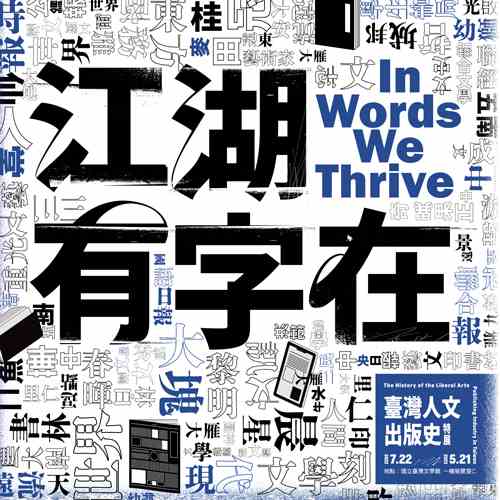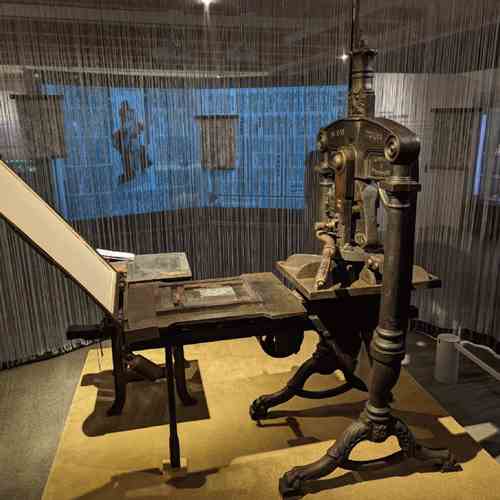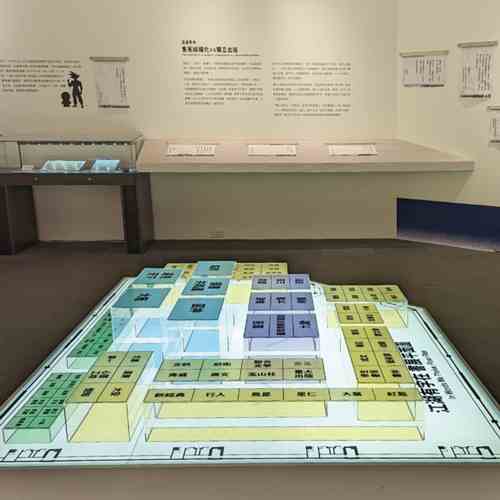Bright days under the press ban - the literary columns of the two official newspapers in Taiwan, as well as literary awards|Why did these people publish magazines? - a burst of literary magazines|Legends, printed pages after pages - the bloom of arts publishers
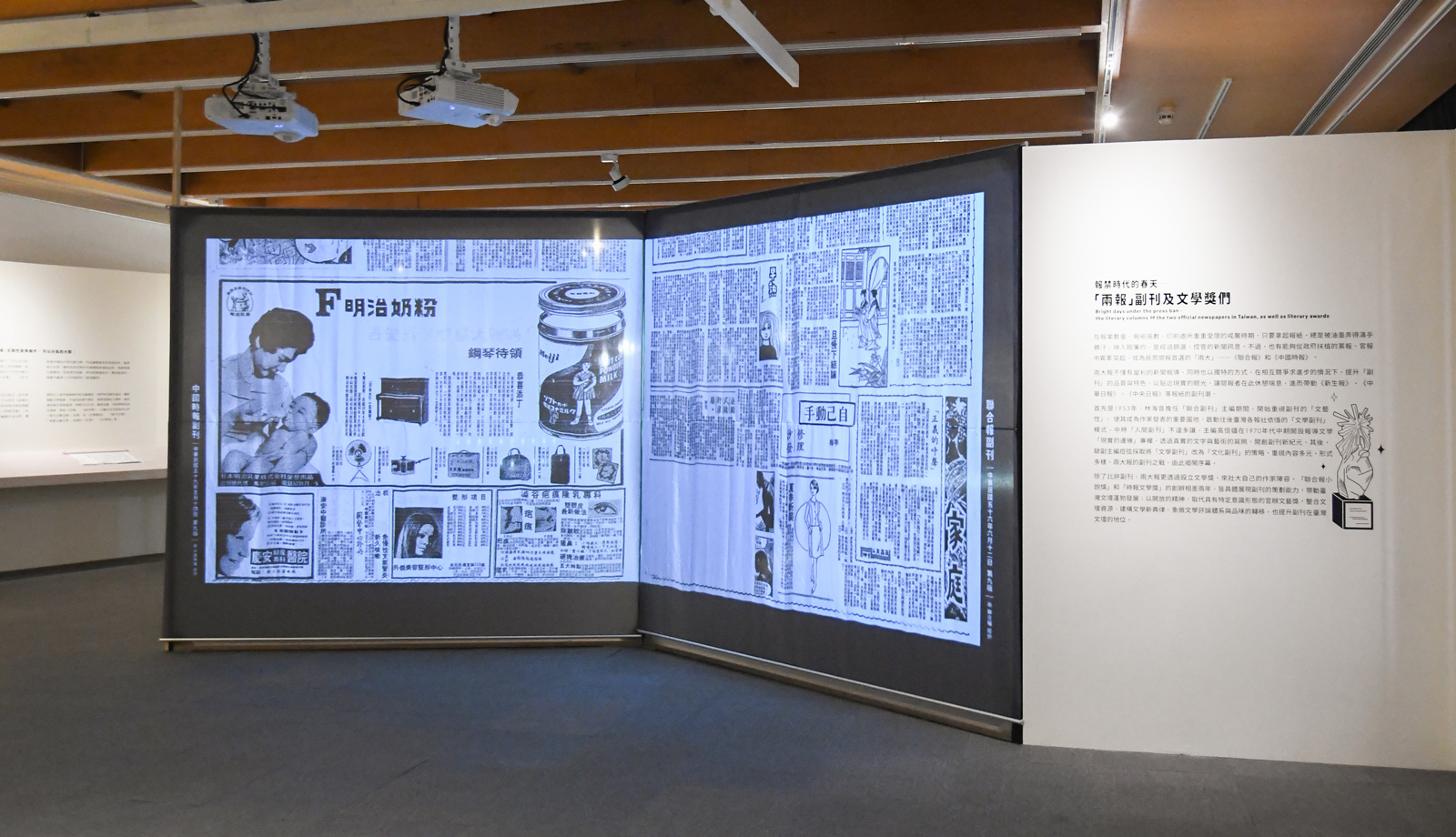
After WWII ended, another new regime was introduced in Taiwan. With the foundation laid by the Japanese government, the publishing industry of Taiwan prospered right after the end of the war. However, soon afterwards, there was a shortage of books due to language and political reasons. The situation was only improved when the five bookstores (Zheng Zhong, Zhong Hua, Shijie, Shangwu, and Kaiming), relocating to Taiwan together with the Kuomintang government, joined the publishing market and printed books on a large scale in the 1950s.
During the martial law period, which lasted more than 30 years, the politics, economy, and education in Taiwan were slowly democratized. Though Taiwan's publishing industry was still under the political influence of the ruling party, in places where the government was unable to intervene, writers and publishers carefully expressed their voices and subtly challenged the government. From the literature section of newspapers, literary magazines, or the publishers focusing on humanist culture, the "quantity" of publications rapidly increased while the "quality" also drastically improved.
Just like the Japanese period, the Chinese reading market began to mature alongside a wide variety of media owing to the "Mandarin policy" and the implementation of 9-year compulsory education. With an increasing number of readers, more and more people devoted themselves to the publishing industry. Consequently, the market was no longer dominated by only a few publishing houses; instead, multiple publishing houses emerged and they either formed alliances strategically or merged together.
In the economically booming 1970s and 1980s, local publishing houses emerged while the first wave of large-scale handovers, reorganization, and innovation appeared. Local publishing houses became the dominant forces in Taiwan's publishing industry. The baby boomers became the pillar of strength in society. Many became prominent people who influenced Taiwan's publishing industry later on. The number of books published in the 1970s was on average beyond 800 every year and in the 1990s, it was more than 40,000. These numbers show that "publishing" could be a good business at the time.
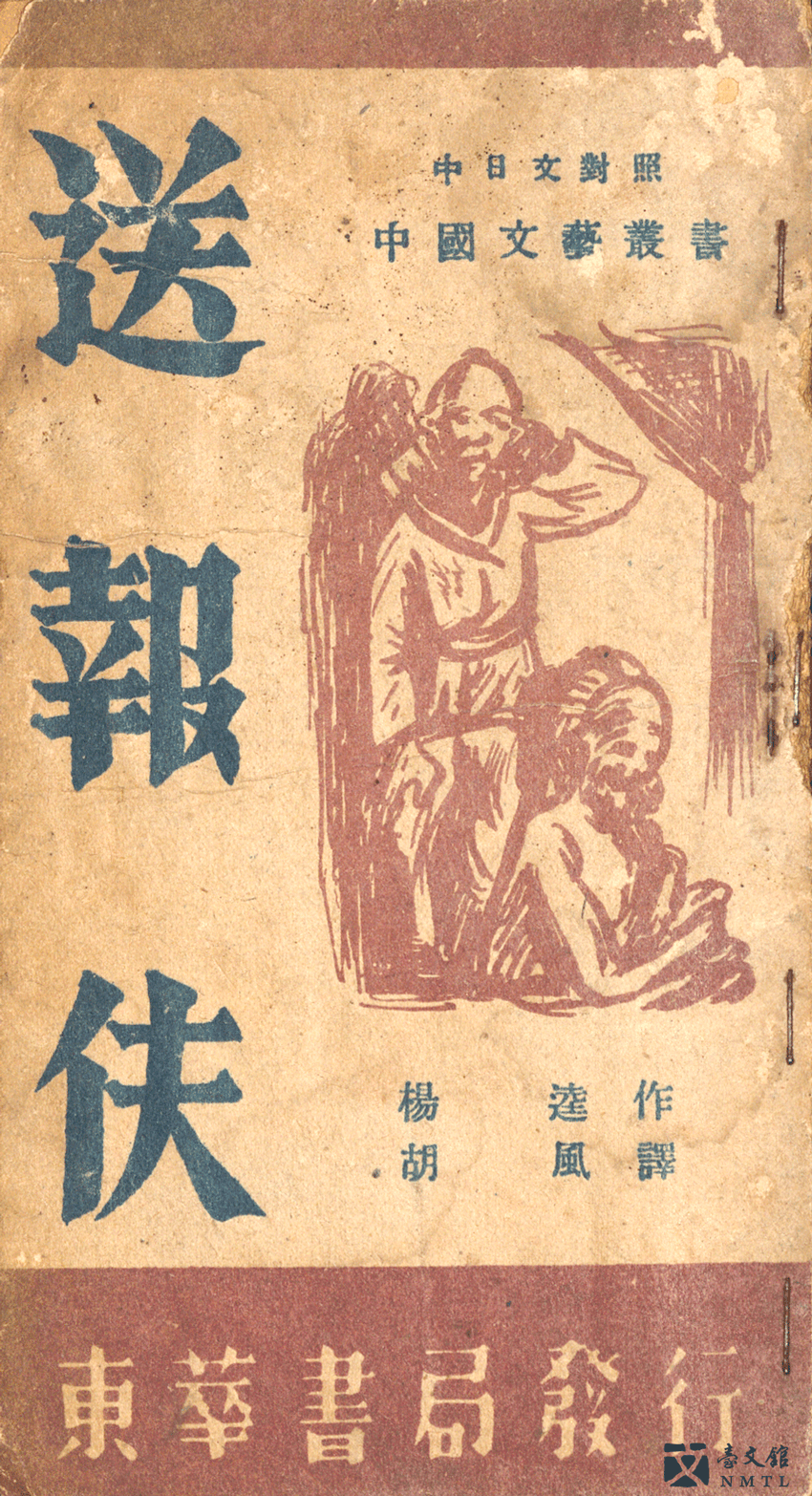
⁍ THE NEWSPAPER CARRIE, Yang Kuei, translated by Hu Feng|Tung Hua Book Co., Ltd., Taipei, 1947.10.
THE NEWSPAPER CARRIE or SHIMBUN HAITATSU FU (Japanese version) first serialized in TAIWAN NEW PEOPLE NEWSPAPER on May 19, 1932 but was banned by the Governor Office soon after. Yang Kuei submitted the novel to Japan's LITERARY REVIEW two years later and received second prize. In 1936, Hu Feng published his Chinese translation in KNOWLEDGE OF THE WORLD, a Shanghai magazine, before including it in MOUNTAIN SPIRITS: KOREA AND TAIWAN SHORT STORIES and NOVELS OF THE WORLD'S ETHNIC MINORITIES. In April of the same year, it was published by Shanghai Culture Publishing House. The Chinese version was specially produced to help the public learn the official language, Mandarin, during the post-war period. (Provided by Lung Ying-tsung/ From the National Museum of Taiwan Literature permanent collection)
Special Column
Beware of Challenging the Regime: the history of banned books
THE LIST OF BANNED BOOKS, compiled by Taiwan Provincial Government and Taiwan Garrison Command in 1982, includes: MANIFEST DER KOMMUNISTISCHEN PARTEI by Karl Marx, THE TRUE STORY OF AH Q by Lu Xun, MODERN HISTORY OF TAIWANESE IN 400 YEARS by Su Beng, and other works by Li Ao, Lei Chen, and Bo Yang. The ban of these books might still seem understandable because they obviously were against the ruling government's ideology. However, the list also includes some baffling examples, such as DAILY CALCULATION MANUAL, MODERN ENGLISH CONVERSATIONS, and CHINA'S CURRENCY, etc.
The book banning restrictions in Taiwan originated from TAIWAN'S MARTIAL LAW in May 1949. The secondary law: RESTRICTIONS ON NEWSPAPERS, MAGAZINES, AND BOOKS UNDER MARTIAL LAW IN TAIWAN, was also introduced. At the time, to prevent the invasion of communist ideology, the Nationalist Government, which had just relocated to Taiwan, eradicated left-wing publications or publications whose authors supported Communism. Later on, the ban spread to three types of publications: "red, yellow, black" (communism, erotism, and criminality). In the meantime, there was a Storm Program involving Chinese martial arts novels; there was also a ban on the works by dissident intellectuals…. With such strong suppression of speech, political reviews, humanities books, biographies, or even novels were all likely to be censored.
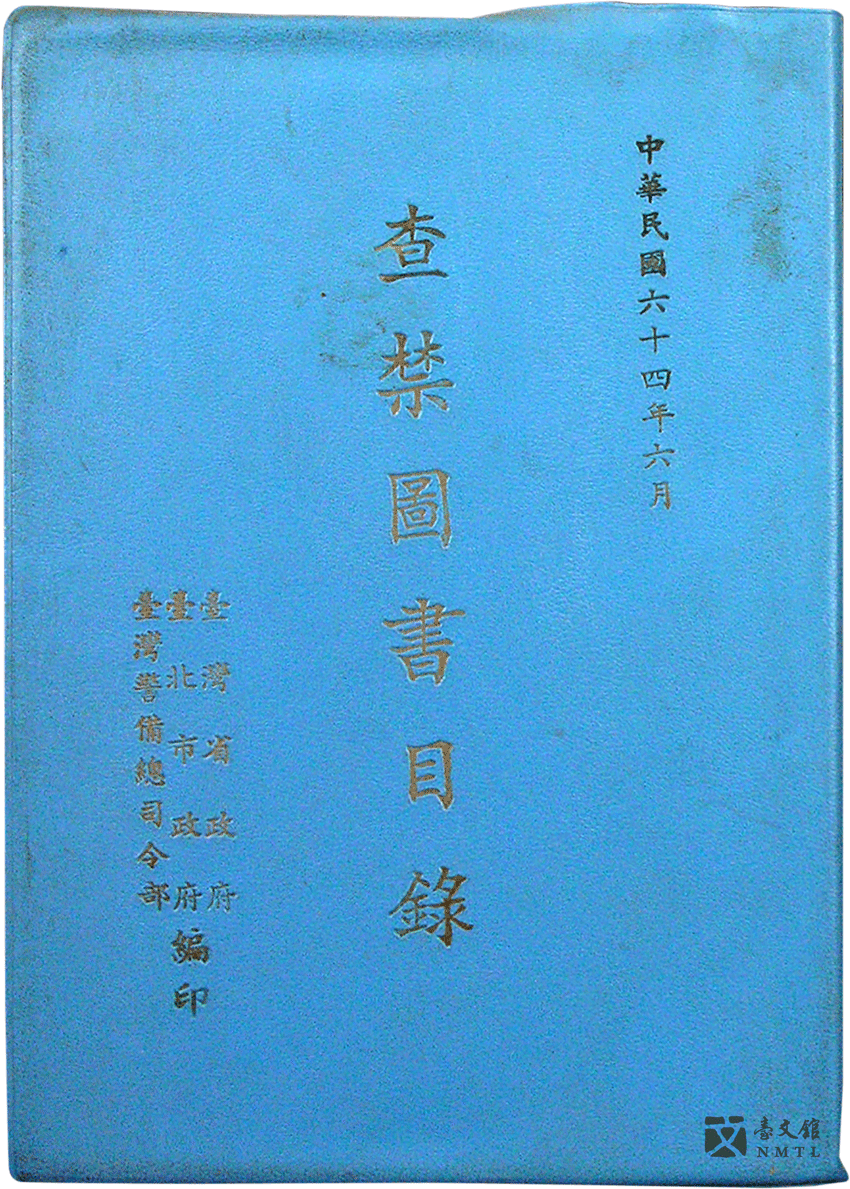
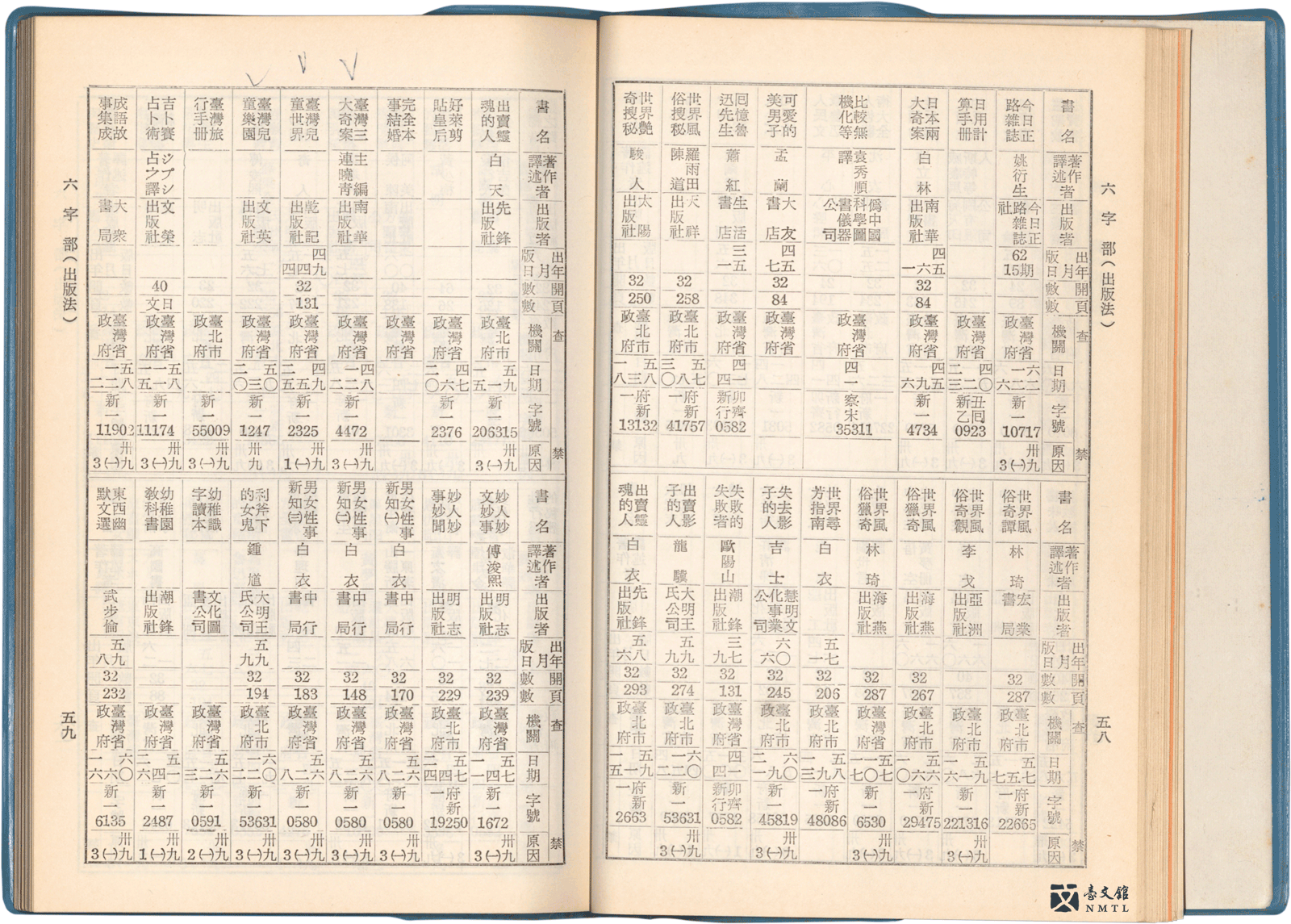
⁍ THE LIST OF BANNED BOOKS, compiled and printed by the Taiwan Garrison Command|1975.6.
How tightly were restrictions enforced on freedom of speech and press during the martial law era? According to THE LIST OF BANNED BOOKS published in 1975, the publications in violation of the Publishing Law, Criminal Code Article 235, social education law and martial law per the Ministry of Interior (47) Memo 22479, or restrictions on newspapers, magazines, and books under martial law in Taiwan, were considered illicit. (Provided by Liang Ching-feng/ From the National Museum of Taiwan Literature permanent collection)
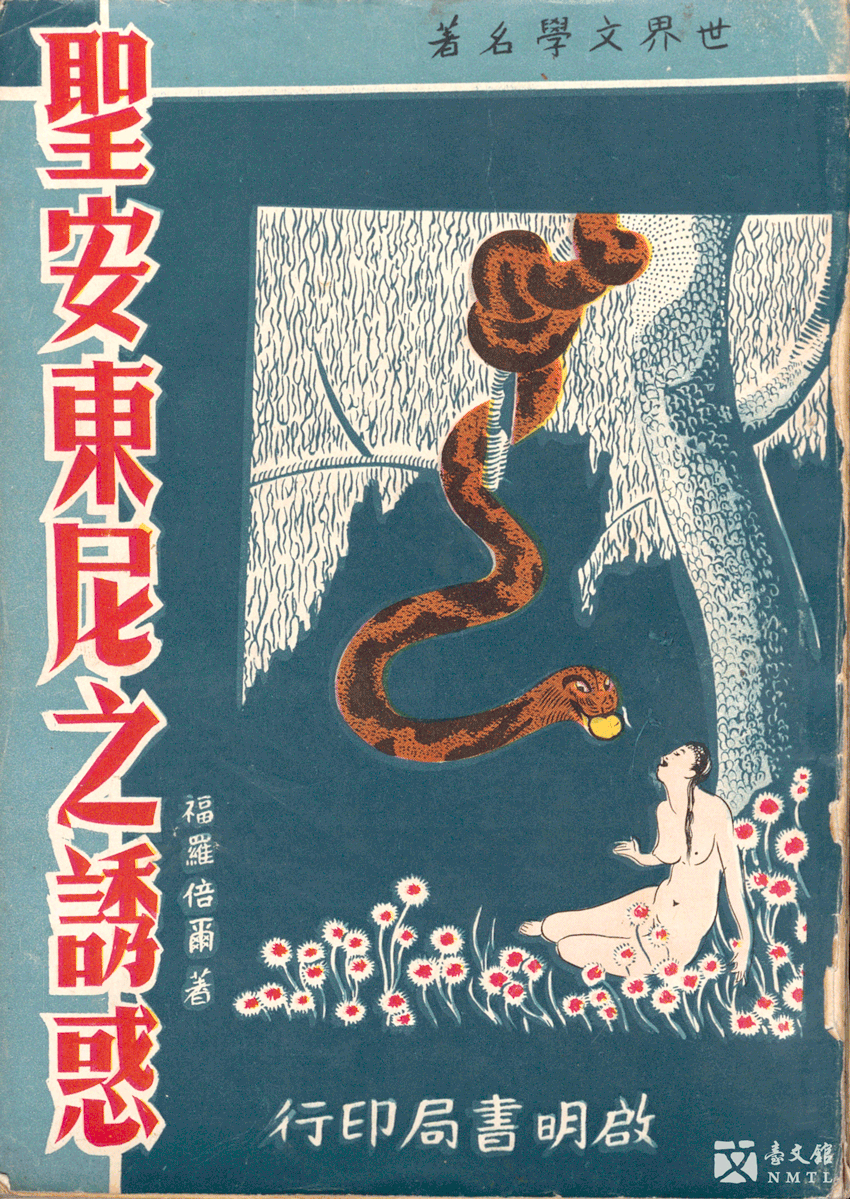
⁍ THE TEMPTATION OF SAINT ANTHONY, Gustave Flaubert, edited and translated by Chi Ming Bookstore|Chi Ming Bookstore, Taipei, 1958.5.
Chi Ming Bookstore was established in Shanghai in 1936. It published many world-famous novels in its early days but fell into the shadow during the White Terror period over its circulation of American journalist Edgar Snow's RED STAR OVER CHINA and an alleged left-wing rhetoric, HISTORY OF CHINESE LITERATURE. THE TEMPTATION OF SAINT ANTHONY was printed in 1957 together with the cover image and Gustave Flaubert's translated Chinese name 福羅倍爾. The book used Chien Kung-hsia's Chinese translation, which was first published in 1936 when Chi Ming Bookstore was still in Shanghai. (Provided by Yao Hai-hsing/ From the National Museum of Taiwan Literature permanent collection)
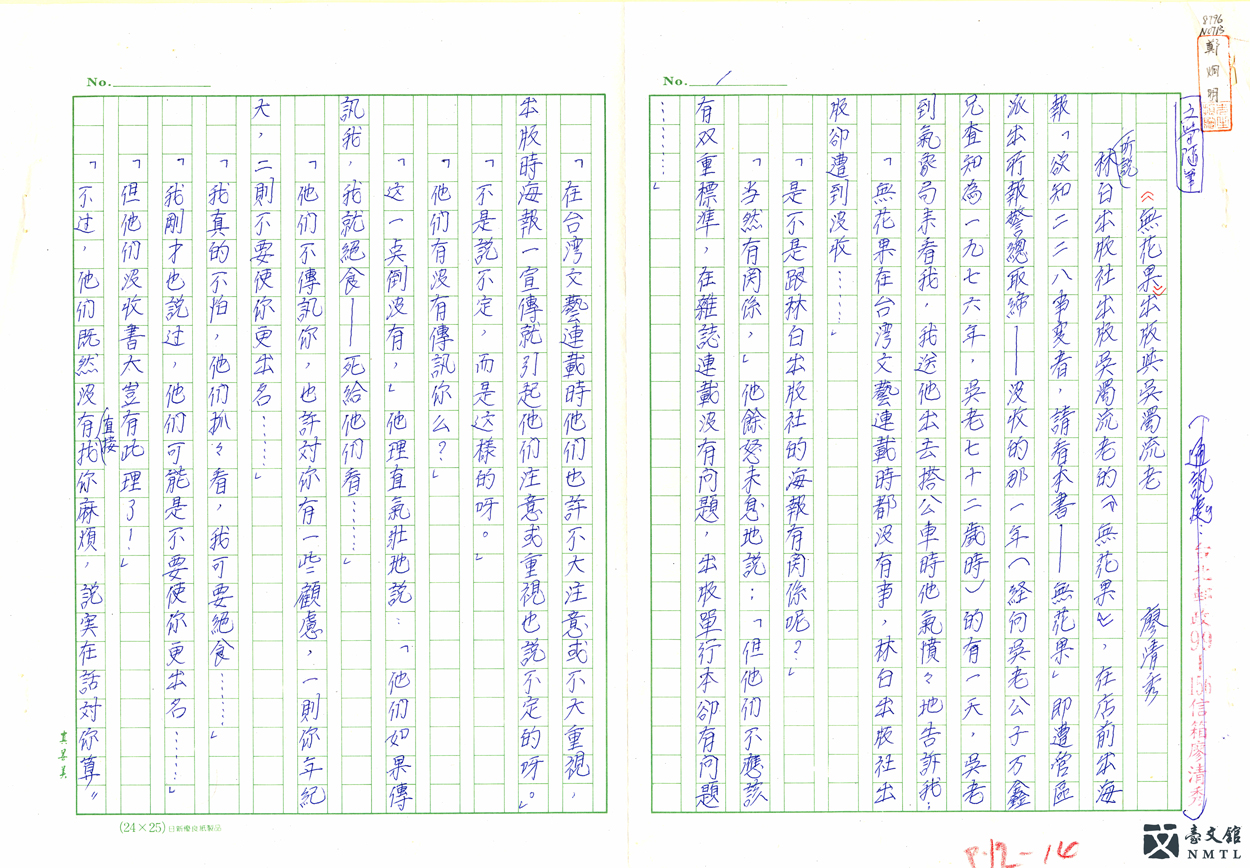
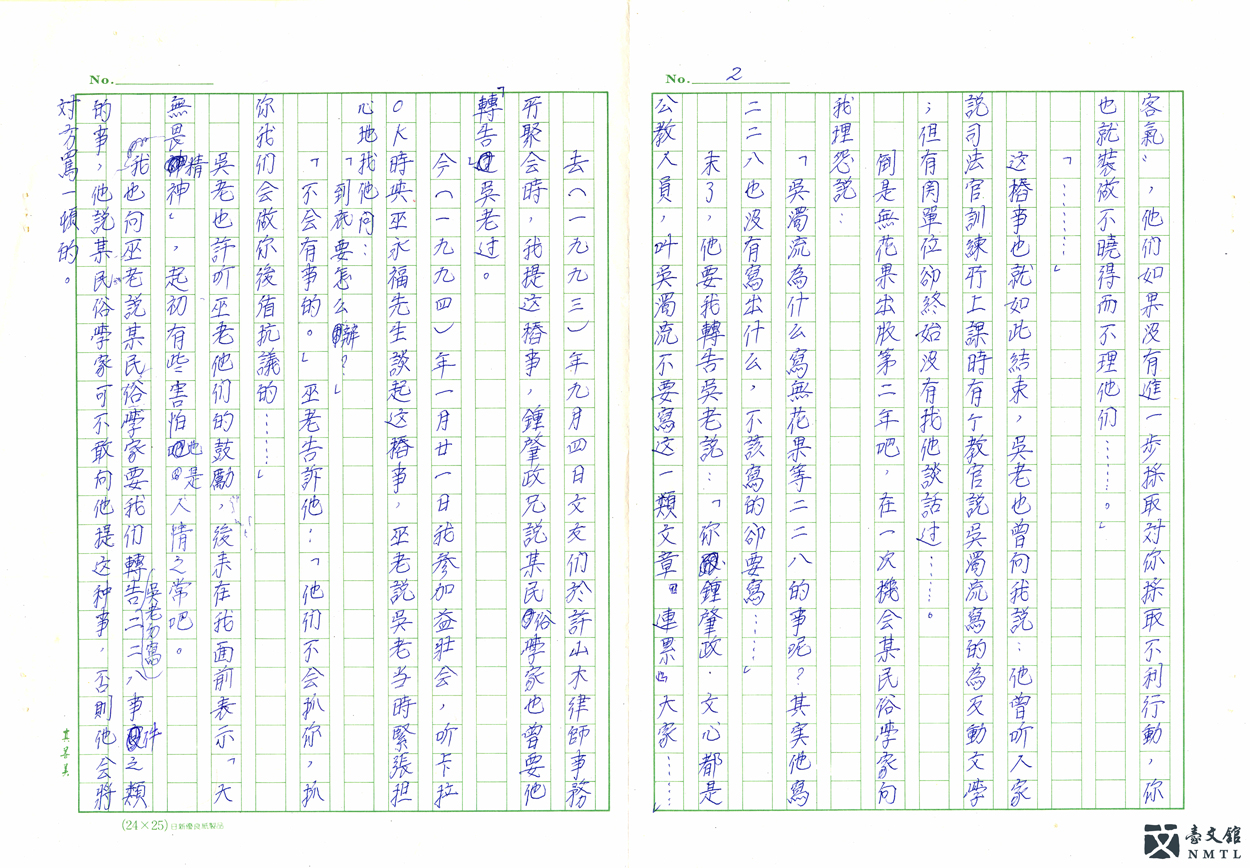
⁍ "The Publishing of THE FIG TREE: MEMOIRS OF A TAIWANESE PATRIOT and Wu Cho-liu" (Manuscript), Liao Ching-hsiu
Wu Cho-liu penned THE FIG TREE: MEMOIRS OF A TAIWANESE PATRIOT in 1968 revolving around the February 28 Incident, and it was serialized in issues 19 to 21 of TAIWAN LITERARY. Later, when Wu Cho-liu offered to invest and requested Lin Bai Publishing print a single edition on his behalf, it was immediately banned by officials on October 10, 1970. This manuscript is Liao Ching-hsiu's recount of a conversation with Wu Cho-liu regarding the banning of the book. The time of the ban mentioned in the first section, 1976, was probably misprinted. (Provided by Literary Taiwan Magazine Publisher/ From the National Museum of Taiwan Literature permanent collection)
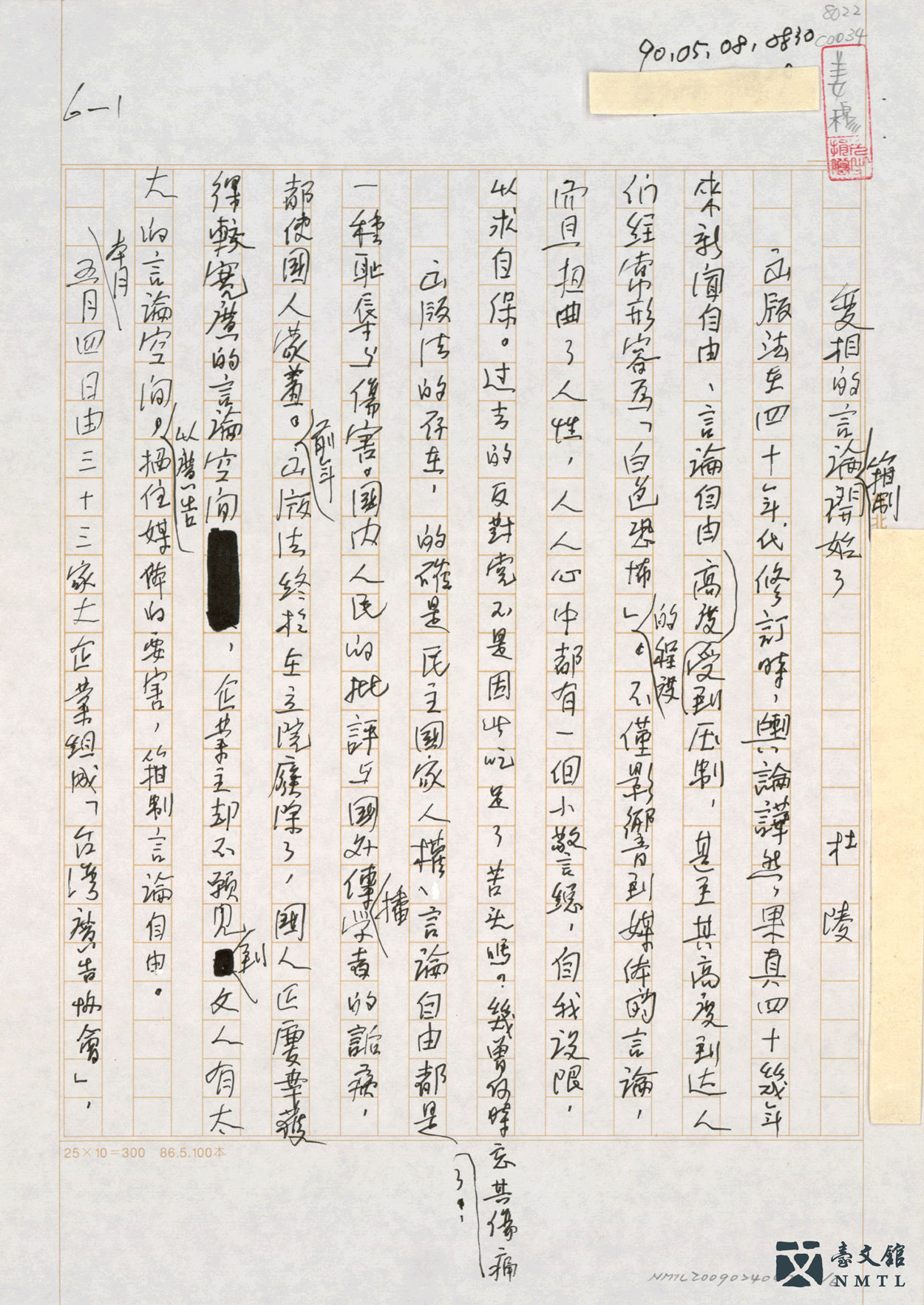
⁍ "A Different Speech Repression Begins" (Manuscript), Tu Ling|2001.5.8.
In January 1999, the Legislative Yuan passed the abolition of the Publishing Law, which by then had been in force for nearly 70 years. Since then, publications did not need to be registered before printing, and penalties such as seizures, confiscations, suspension of distribution, and fines after publishing were also lifted. However, Tu Ling pointed out in this manuscript that following the repeal, some businesses established the "Taiwan Advertising Association" in an attempt to sanction media programs and news reports with the lure of advertisements, a move no different from the control of speech in the authoritarian era. (Provided by Chiang Mu (Mu Yeh) / From the National Museum of Taiwan Literature permanent collection)
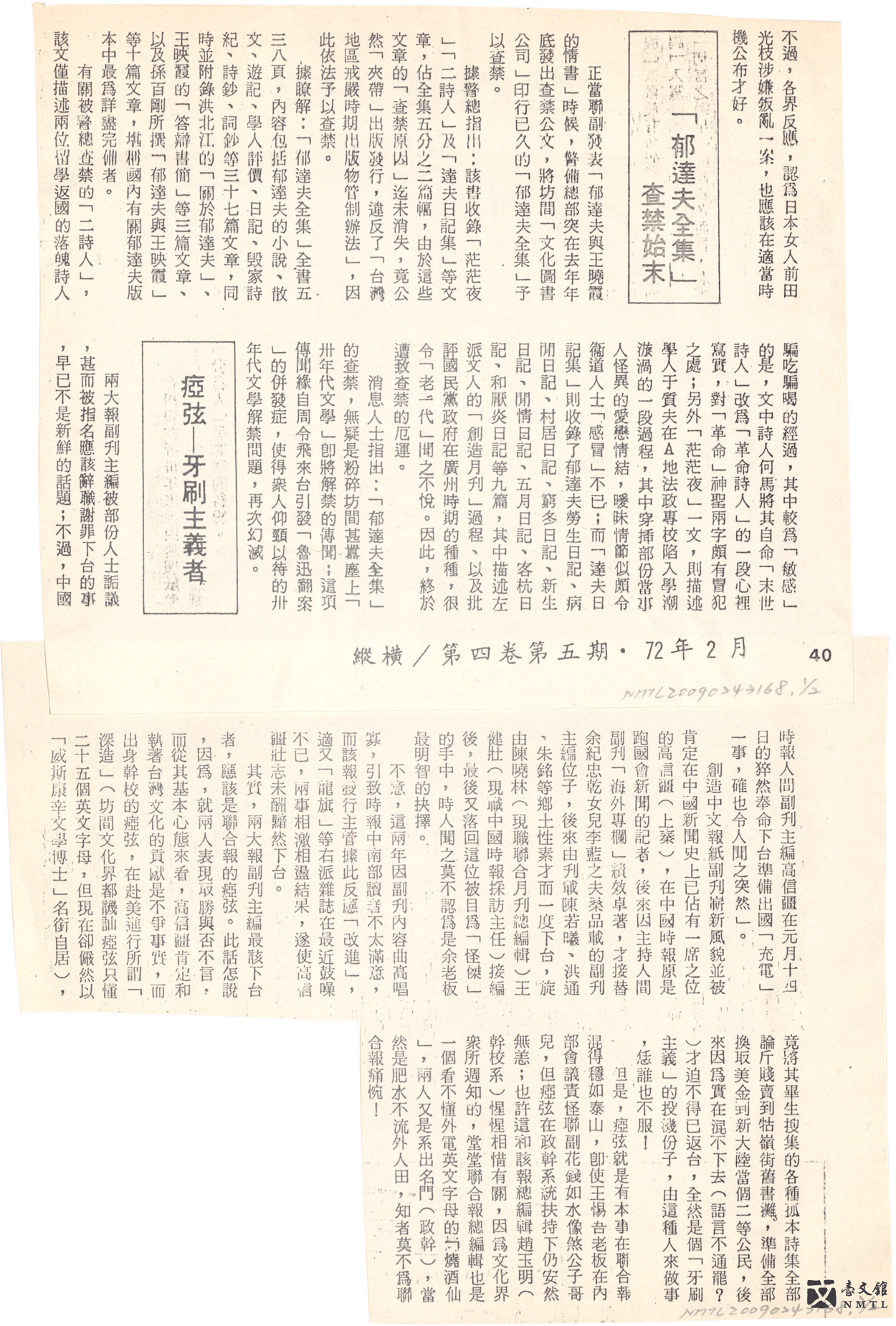
⁍ "The Ban on COMPLETE WORKS OF YU DA-FU," ASPECT, Volume 4, Fifth Issue|1983.2 (page 40).
Founded by Cheng Lin-an in 1981 and led by editor-in-chief Sung Wen-cheng, ASPECT was one of several Tangwai magazines of the 1980s. This short article reveals in detail the reasons behind the ban of Culture Book Company's COMPLETE WORKS OF YU DA-FU in 1982 – primarily because its chronicled articles, including "Boundless Night," "Two Poets," and "Da Fu's Diary Collection," were considered "offensive" to the Kuomintang government and its supporters. (Provided by Chiang Mu (Mu Yeh) / From the National Museum of Taiwan Literature permanent collection)
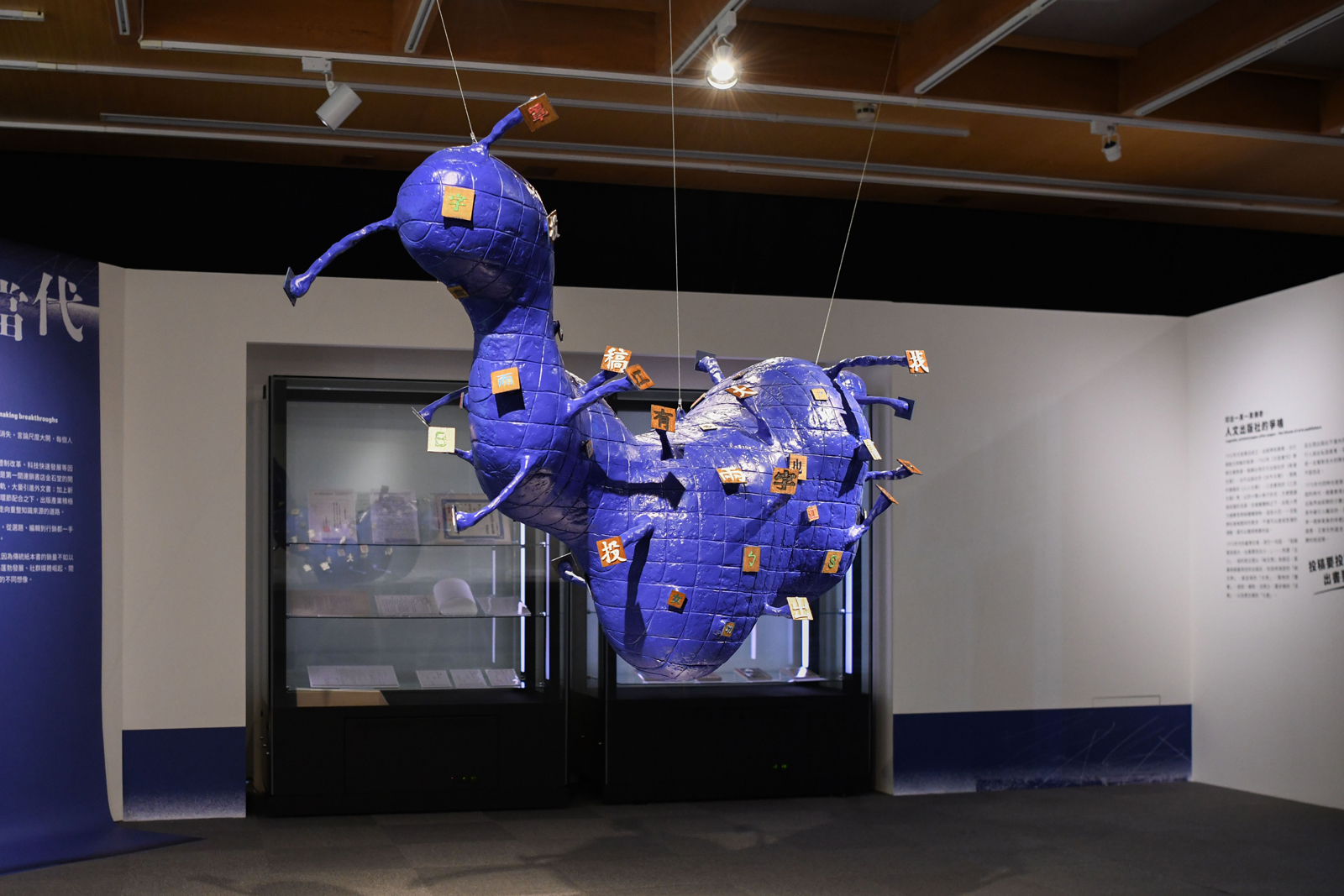
◎ Word Cloud (Tsai Kun-lin, Quan Cheng Art Studio)
The longitudinal and latitudinal lines on the cloud demonstrate the changes in the application of lead type pieces in different times. The rich manifestation of characters includes type pieces with convex and concave carvings, high and low surfaces, and radiating forms. The various colors demonstrate the diversity of the publication history as well as the vibrancy and rush of undercurrent. "Go to two major newspapers for article submissions; go to five small publishers for book publications." It is a vivid representation of the literacy scene and the publishing market. When reading the words on the exhibit, the viewer can freely combine the characters. By doing so, the viewer can connect him/herself with the exhibit and the meaning of the exhibition.
Bright days under the press ban - the literary columns of the two official newspapers in Taiwan, as well as literary awards
During the martial law period, the number of newspaper agencies, the number of pages in a newspaper, and the locations of printing were all restricted. At that time, whenever people picked up a newspaper, they would find their hands stained with newspaper ink. The newspapers back then only reported selected and controlled news articles. However, some newspapers stood out among government-supported party or state newspapers and became two top choices for news among Taiwanese people: UNITED DAILY NEWS and CHINA TIMES.
These two major newspapers provided critical news coverage and strove to enhance the quality and distinguishing features of their "supplements" using unique approaches in a competitive atmosphere. They allowed readers to take a break by providing a realistic perspective and inspired other papers such as TAIWAN SHIN SHENG DAILY NEWS, CHUNGHWA NEWSPAPER and CENTRAL DAILY NEWS to add supplements to their publications.
In 1953, Lin Hai-yin acted as the Editor-in-Chief of the supplement of UNITED DAILY NEWS. During her tenure, the newspaper began to place importance on the literary value of its supplement, making it an important place for writers to submit their works. It helped create the pattern of a "literary supplement," which was followed by other newspaper agencies later on. The "Human Realm supplement" of CHINA TIMES was also equally important at the time. The Editor-in-Chief Kao Hsin-chiang launched a journalistic column called "The Edge of Reality" in the mid 1970s. Through realistic writings and art, CHINA TIMES began a new chapter for newspaper supplements. Later on, Ya Hsien, the Editor-in-Chief of the UNITED DAILY NEWS supplement, changed the "literary supplement" to the "cultural supplement," focusing on diversity of content and different forms of representation. The competition for the best supplement between the two newspapers kicked off during this time.
Apart from the competition for running the best supplement, the two newspapers also organized literary awards to strengthen their teams of writers. "United Daily News Novel Awards" and "China Times Literary Awards" were consecutively established within two years. Both newspapers demonstrated their ability to plan such events and facilitated the vibrant development of the literary world in Taiwan. With a liberated attitude, these awards replaced the state literary awards aiming to spread the regime's ideology. They also helped integrate the resources of the literary scene and constructed new rules for literature. Furthermore, they symbolized the shift of the structure of literary criticism and literary taste as well as enhancing the status of newspaper supplements in Taiwan's literary world.
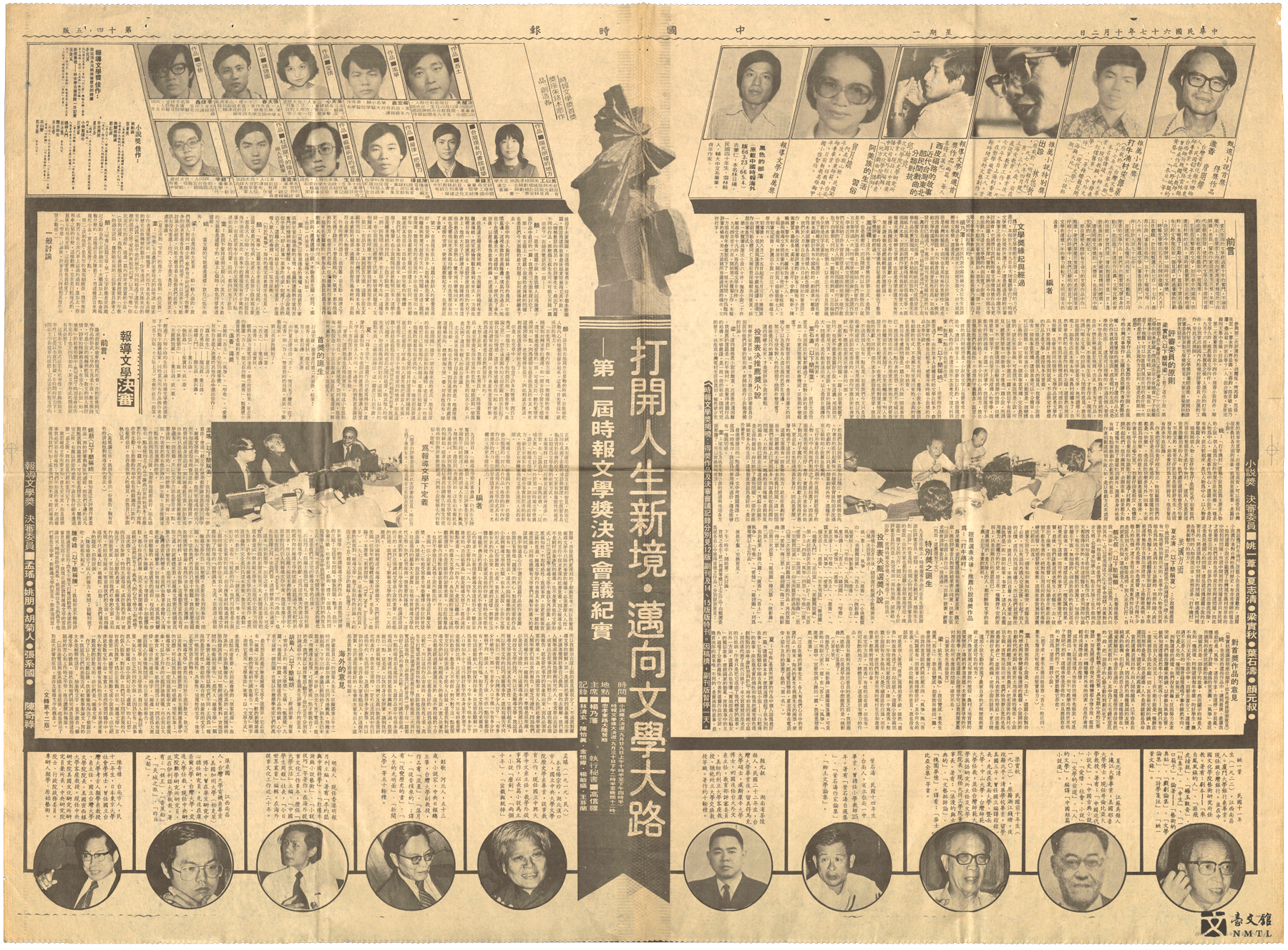
⁍ "Start A New Chapter in Life. Take on The Path of Literature: Meeting Minutes of The 1st China Times Literary Awards Final Winner Selection" CHINA TIMES, noted by Lin Ching-hsuan et al.|1978.10.2.
In 1978, the first China Times Literary Awards started to accept submissions on May 9th. August 15th was the deadline. In total, 717 entries were received with 50 recommended novels. There were also 180 journalistic writings and 44 recommended journalistic writings. On September 29th, the meeting for selecting the winner was held at the Dalu Restaurant on Zhongxiao East Road. Director Yang Nai-fan acted as the chair; Executive Secretary Kao Hsin-chiang announced the judging process before it started. (Provided by Yao Hai-hsing/ From the National Museum of Taiwan Literature permanent collection)
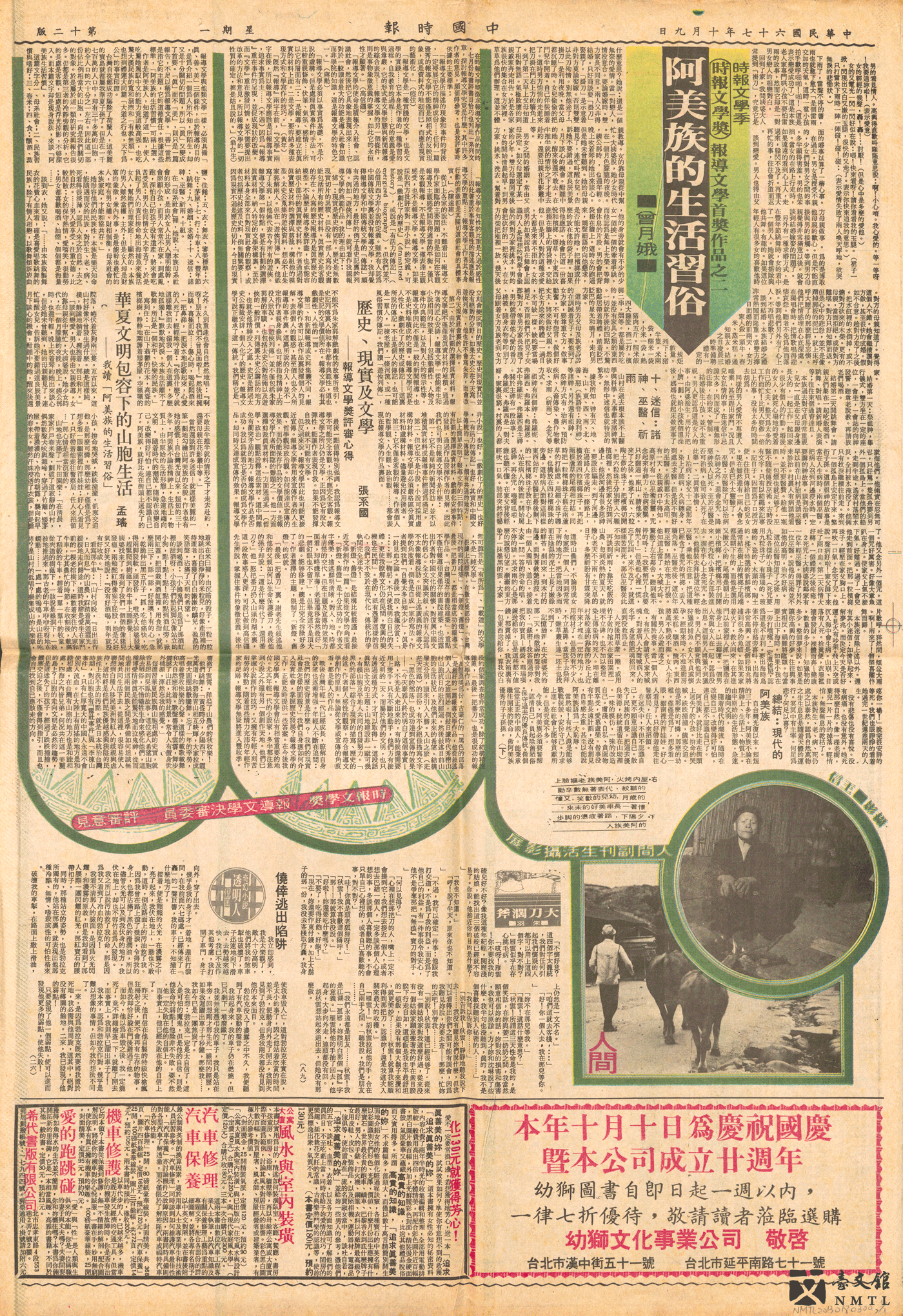
⁍ "Amis Culture and Customs," CHINA TIMES, Tseng Yueh-er|1978.10.9.
In 1978, CHINA TIMES established the Times Literary Awards. The inaugural edition was dedicated to fiction and reportage, with the first reportage award presented to Amis teacher Tseng Yueh-e for her submission "Amis Culture And Customs." A precursor for Taiwanese indigenous people in the literary scene, the narrative revolved around the daily life of Amis people, and shared humble details describing clothing, food, shelter, and means of travel. (Provided by Ku Meng-jen/ From the National Museum of Taiwan Literature permanent collection)
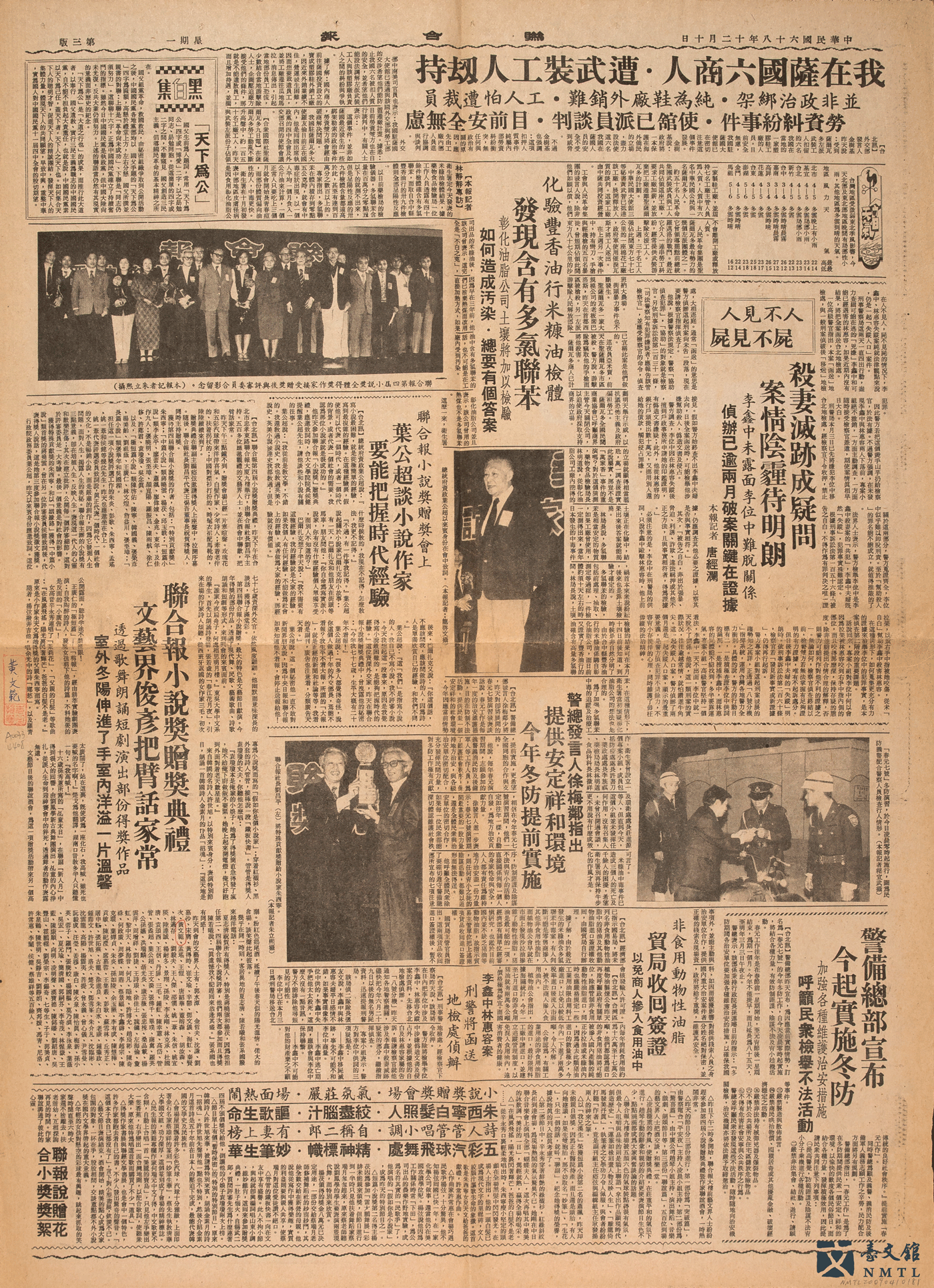
⁍ "United Daily News Fiction Awards Ceremony" reportage, UNITED DAILY NEWS|1979.12.10.
(Provided by Huang Wen-fan/ From the National Museum of Taiwan Literature permanent collection)
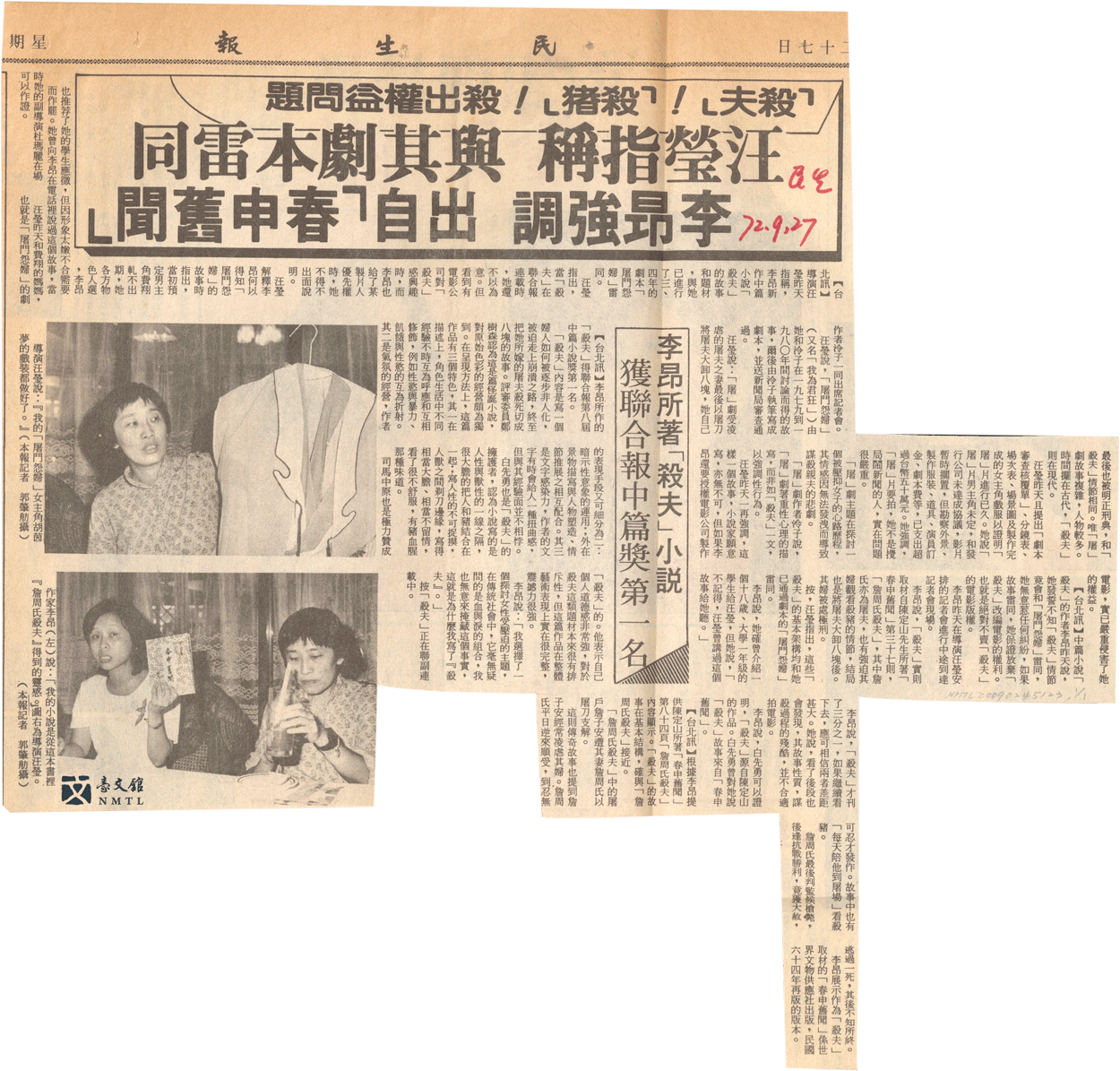
⁍ "The Butcher's Wife by Li Ang Wins First Place at United Daily News Novella Awards," MIN SHENG BAO|1983.9.27.
To commemorate the 25th anniversary of UNITED DAILY NEWS in 1976, then deputy editor-in-chief Ma Ko created "United Daily News Fiction Awards," which became the first national paper to encourage creative writing with cash prizes. Its selection mechanism also laid the groundwork for future Taiwan literature awards. In 1983, Li Ang won first prize of the Novella Awards for "The Butcher's Wife" which was widely debated due to its sensational subject matter. (Provided by Chiang Mu (Mu Yeh) / From the National Museum of Taiwan Literature permanent collection)
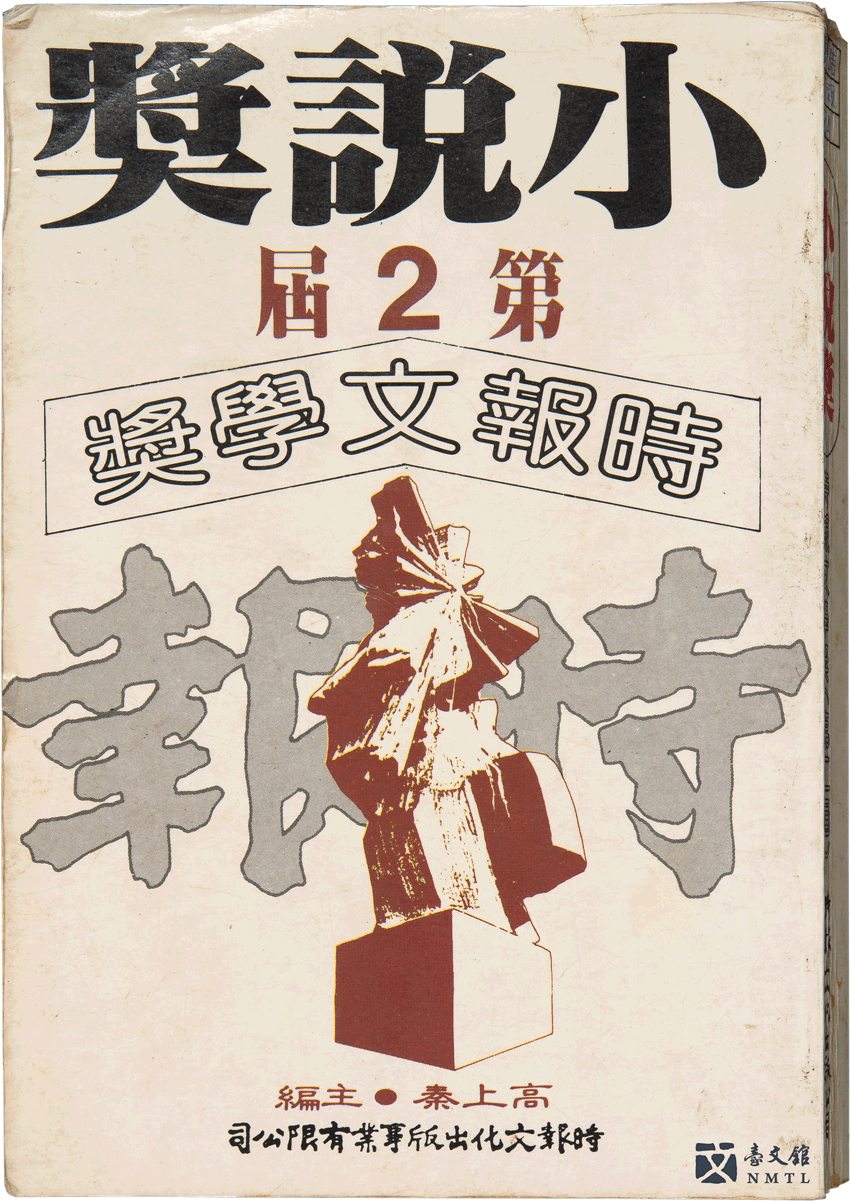
⁍ THE SECOND TIMES LITERARY AWARDS (Fiction Novels), Editor-in-Chief Kao Shang-chin |China Times Co, Taipei, 1983.4.
Under the lead of Kao Shang-chin, the second Times Literary Awards introduced categories for narrative poetry and prose. This collection showcases award-winning entries such as Huang Fan's "Laisuo," excellent works by Pao Chen, Zhang Gui-xing, Hu Tai-li, and works of honorable mention award by Chu Tien-hsin, Wu Chin-fa, and Chung Yen-hao. "Phoenix Flowers in The Monsoon" by Ku Meng-jen and "Fanxiulou," co-authored by 14 writers including Hong Kong Beidou Society's Tung Tung, were also commended. (Provided by Lin Chin-peng's family/ From the National Museum of Taiwan Literature permanent collection)
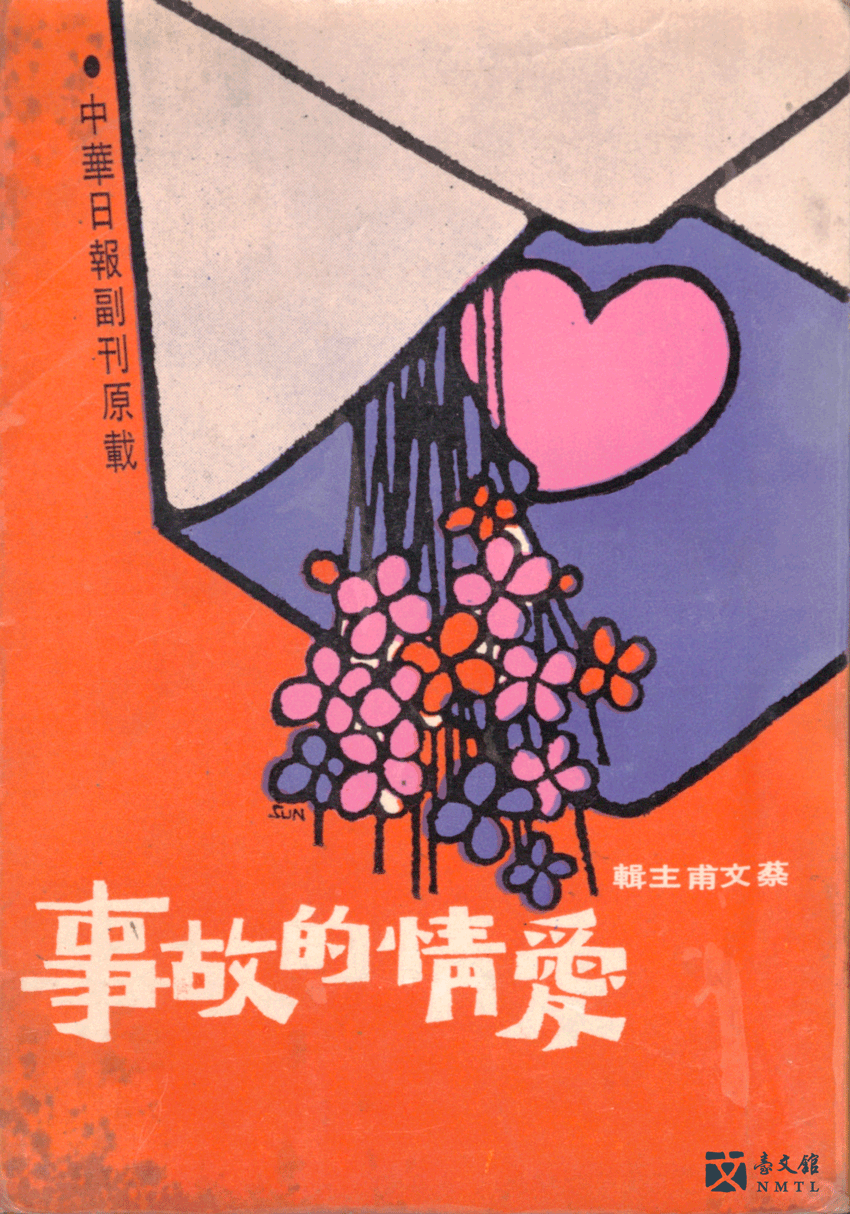
⁍ THE STORY OF LOVE, edited by Tsai Wen-fu|Crown Publishing, Taipei, 1972.7.
In 1971, Tsai Wen-fu was appointed editor-in-chief of the CHUNGHWA NEWSPAPER supplement. Upon taking the reins, he began to consider and define the readership distribution, eventually focusing on articles of similar or higher quality for the supplement and inviting local as well as foreign writers to contribute extensively. THE STORY OF LOVE was first published in the CHUNGHWA NEWSPAPER supplement, later edited by Tsai Wen-fu and printed by Crown Publishing. (Provided by Chou Chung-hsun (Hsiao Pai) / From the National Museum of Taiwan Literature permanent collection)
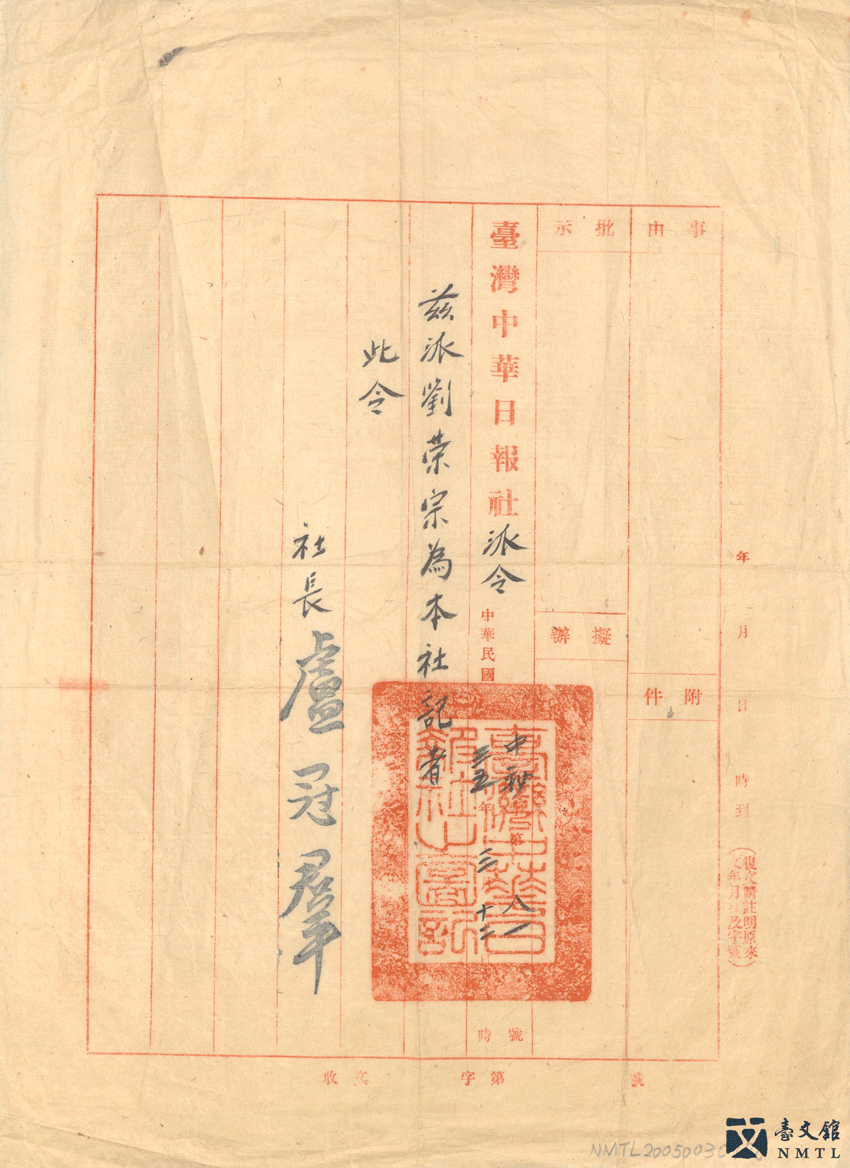
⁍ CHUNGHWA NEWSPAPER Japanese Edition Appointment|1946.
From March to October 1946, seasoned writer Lung Ying-tsung (Liu Jung-tsung as the real name) was assigned to Tainan as editor-in-chief for the literary arts section of CHUNGHWA NEWSPAPER's Japanese edition. The Nationalist government at the time strongly enforced "the policy of official language, Mandarin." The literary arts section became one of the few publications where Japanese writers in Taiwan could share their works, and one that introduced world literature to Taiwanese readers, while rebuilding cultural awareness and social justice, which amply revealed Lung's foresight and persistence. (Provided by Lung Ying-tsung/ From the National Museum of Taiwan Literature permanent collection)
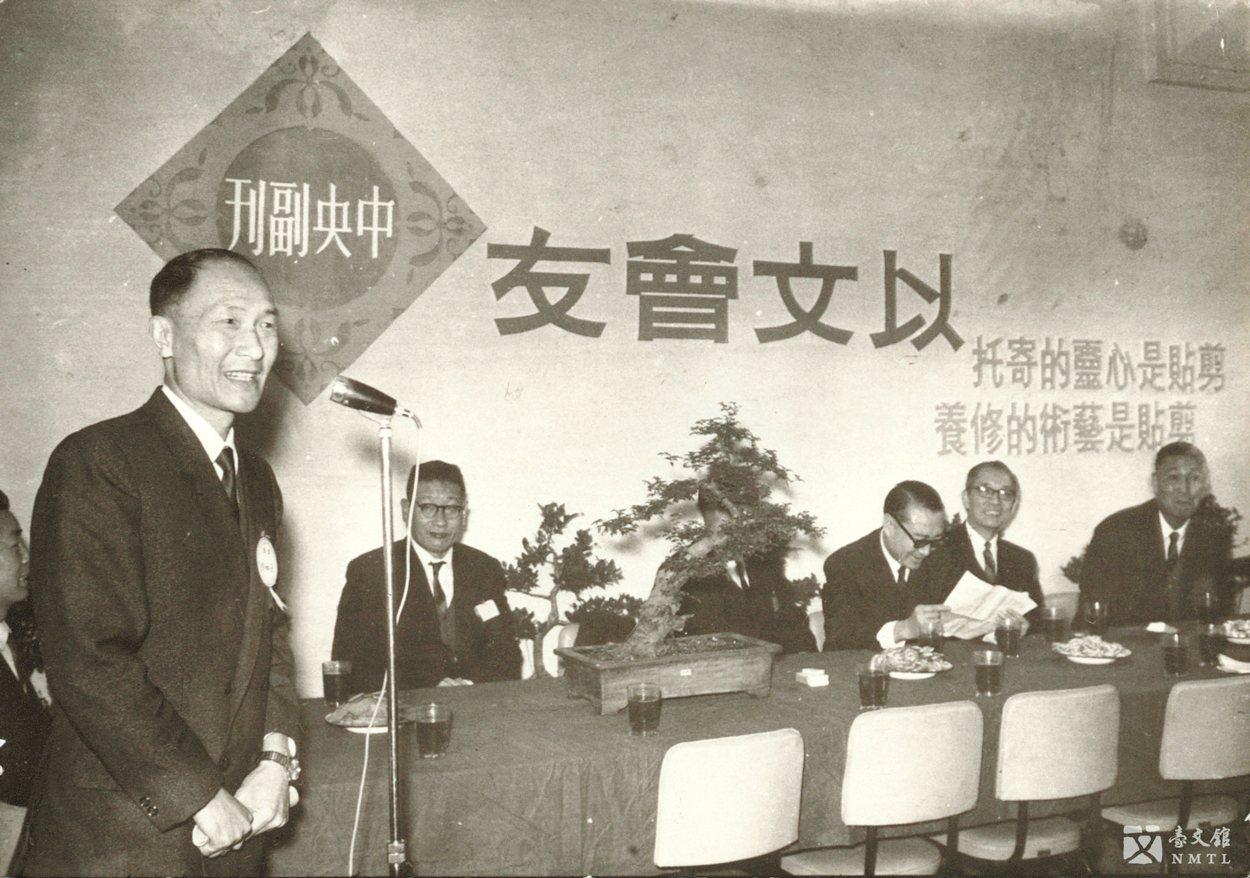
⁍ Sun Ju-ling Speaks at Symposium of Association on Literary Grounds held by CENTRAL DAILY NEWS Supplement|Unknown Photographer, 1970.
The official mouthpiece of the Kuomintang, CENTRAL DAILY NEWS was founded in Shanghai in February 1928, and moved to Taiwan with the Nationalist government in 1949. The print version was discontinued in 2006 and moved online before completely ceasing publication in 2018. Sun Ju-ling was editor-in-chief of Central Daily News Supplement for nearly 30 years, cultivating numerous literary talents during his time. Like the supplements of CHINA TIMES and UNITED DAILY NEWS, it was considered a key literary arts publication in the 1970s and 80s. (Provided by Sun Ju-ling/ From the National Museum of Taiwan Literature permanent collection)
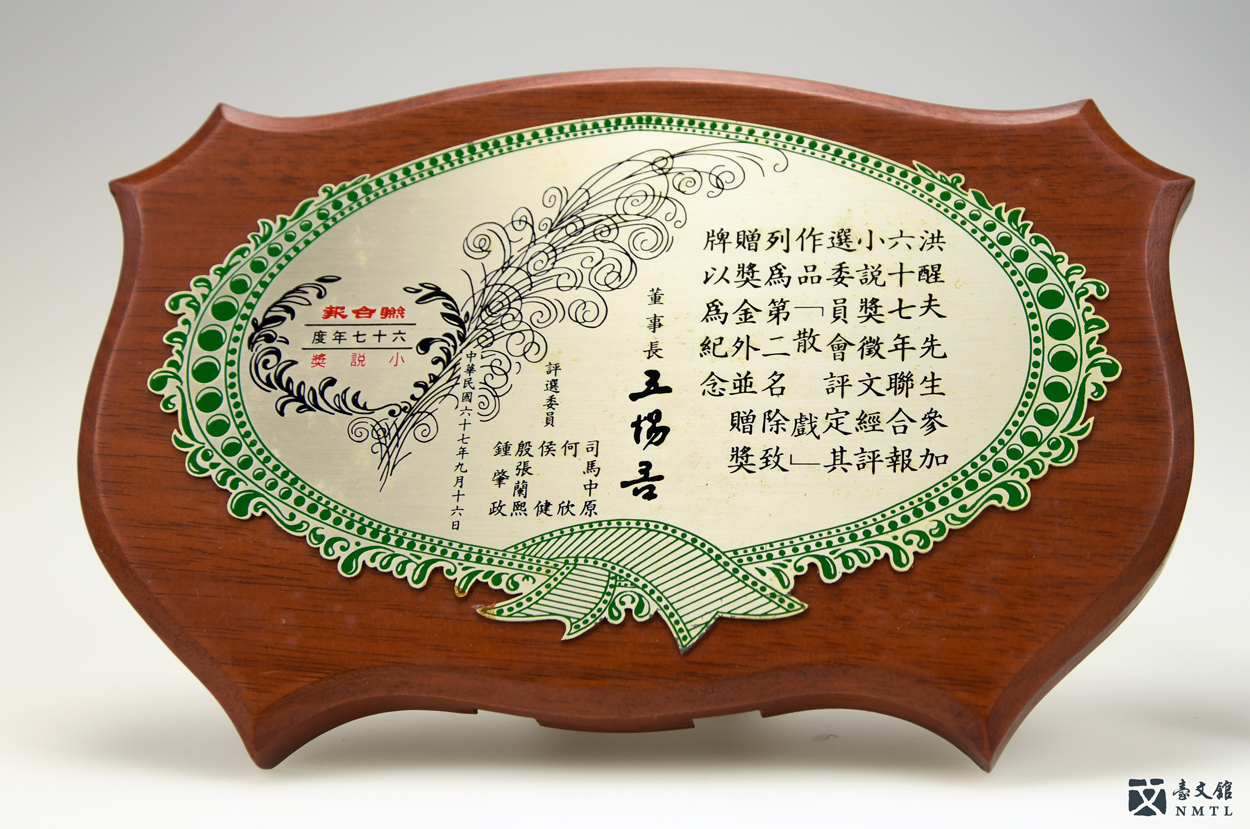
⁍ Hung Hsing-fu Named First Runner-Up at Third United Daily News Novel Awards|1978.9.16.
Hung Hsing-fu (1949-1982), whose real name was Hung Ma-tsung, became an elementary school teacher after he graduated from National Taichung University of Education. He also founded the magazine THIS GENERATION and took part in The Waves Poetry Society. Hung was recognized for his compassionate and detailed writing style used to convey the lavish Ukiyo-e scenes of Taiwan's social transformation. In 1978, his work "My Land" won the Excellence Award in Novel Selection at the first China Times Literary Awards and "A Slackened Opera" claimed the second prize at the United Daily News Novel Awards. (Provided by Lin Pi-Yun/ From the National Museum of Taiwan Literature permanent collection)
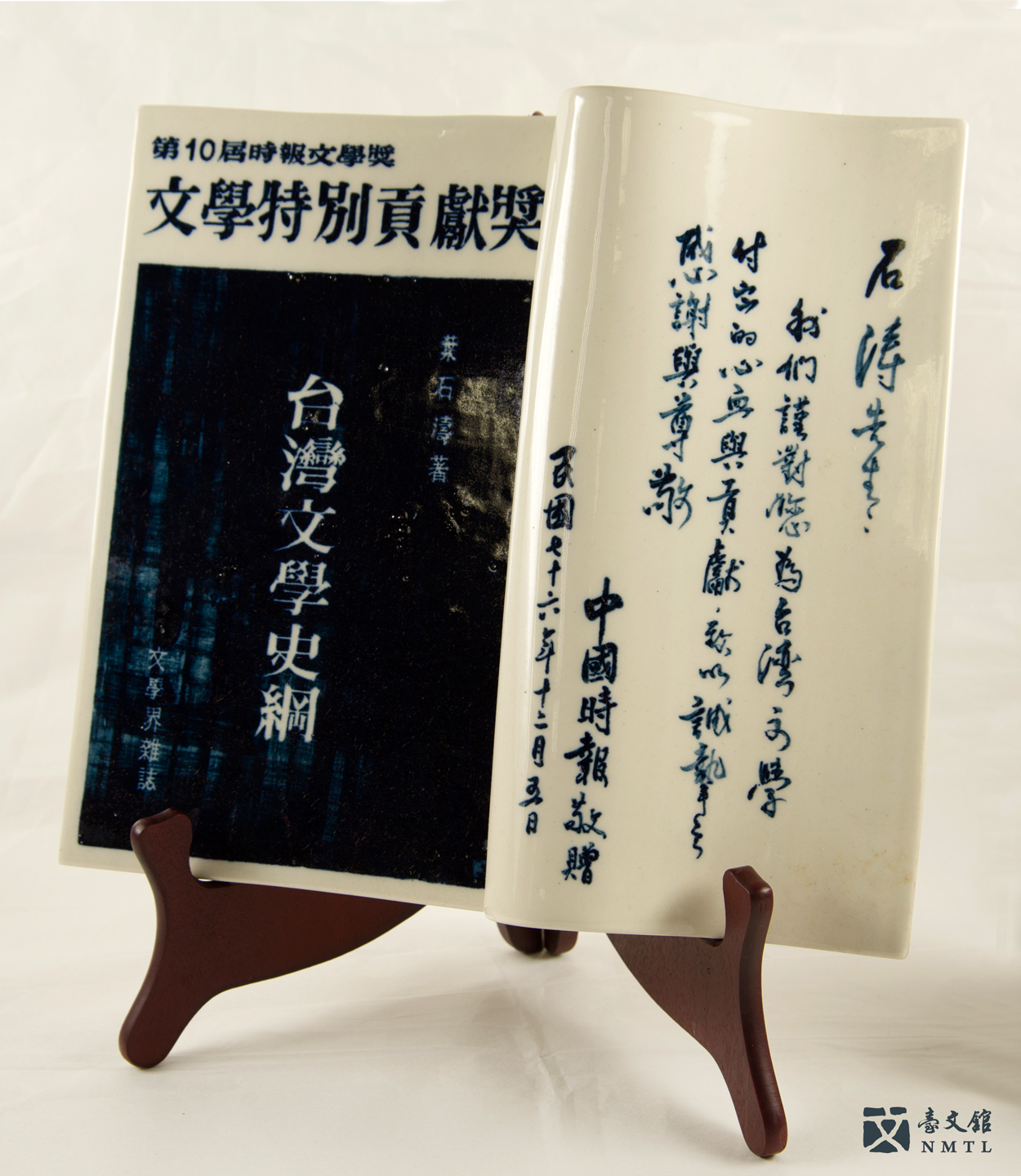
⁍ Yeh Shih-tao Received "Special Contribution to Literature" Trophy at the 10th China Times Literary Awards|1987.12.5.
Since its inception, the China Times Literary Awards has had a recommendation prize and selection prize for each award category. A "Special Contribution to Literature" award was introduced in 1986 at the 9th China Times Literary Awards. Under the recommendation of author Chi Chi, this award was presented to Yeh Shih-tao in 1987 at the 10th China Times Literary Awards for THE CHRONICLE OF TAIWANESE LITERATURE; then the chairman of CHINA TIMES, Yu Chi-chung, remarked that it "was well deserved given Yeh's meaningful contributions to Taiwan literature." (Provided by Yeh Shih-tao/ From the National Museum of Taiwan Literature permanent collection)
Why did these people publish magazines? - a burst of literary magazines
During the press ban, the length and content of newspapers were largely restricted; yet literary magazines enjoyed more freedom although they targeted a smaller audience. Their ability to carry extensive texts made it possible for them to present such experimental works as avant-garde and abstruse writings. Therefore, they bore the responsibility of promoting literature and provided essential impetus for the Chinese book market in Taiwan after WWII, leading to an exponential increase in literary magazines.
The literary magazines at this stage can be divided into four categories based on factors such as reader types and genres:
Official literary magazines supported by the government were free of market pressures, so they were able to fully follow government policies. The budding writers involved in these publications often entered the government and took charge of literary movements. With increasing awareness of localism, this type of magazine slowly declined around the nativism literary movement in the 1970s. Representative magazines included: MILITARY LITERATURE, NEW LITERATURE, LITERARY CREATION.
The campus magazines are still active today. There have long been young literature enthusiasts fond of writing. From middle school to university, there have been a variety of literary publications. YOUTH LITERARY, which was born in 1954, was used as a tool for promoting patriotism among students. However, it later received writers' submissions and to this day, it is still seeking innovation. MINGDAO LITERATURE & ARTS, with its first issue published in 1976, aimed to enhance students' Chinese proficiency and to provide literary cultivation; due to excellent editing skills, it received lavish praise from the literary world and spread outside the campus.
The general literary publications that appealed to the market focused on presenting popular and secular works attractive to the general public. Although they were easily affected by the market mechanism and popular taste, to some extent they still contributed to the promotion of literature. Among all, the most successful and long-standing one was CROWN MAGAZINE, founded by Ping Hsin-tao in 1954.
The pure literature magazines founded by scholars or writers contributed to the development of literature mostly due to their shared beliefs. However, the source of their financial aid was unstable, so they often sought sponsorships from private connections or academic institutions. These magazines can be generally divided into several categories: ones that emphasized inclusiveness and had no specific claims, e.g., LITERARY SCENE and BELLES-LETTRES MONTHLY. There were also "modernist literature" coming from the Department of Foreign Languages and Literatures, National Taiwan University, such as LITERARY REVIEW, MODERN LITERATURE QUARTERLY, and "realist literature," such as LITERATURE QUARTERLY and LITERARY WORLD.
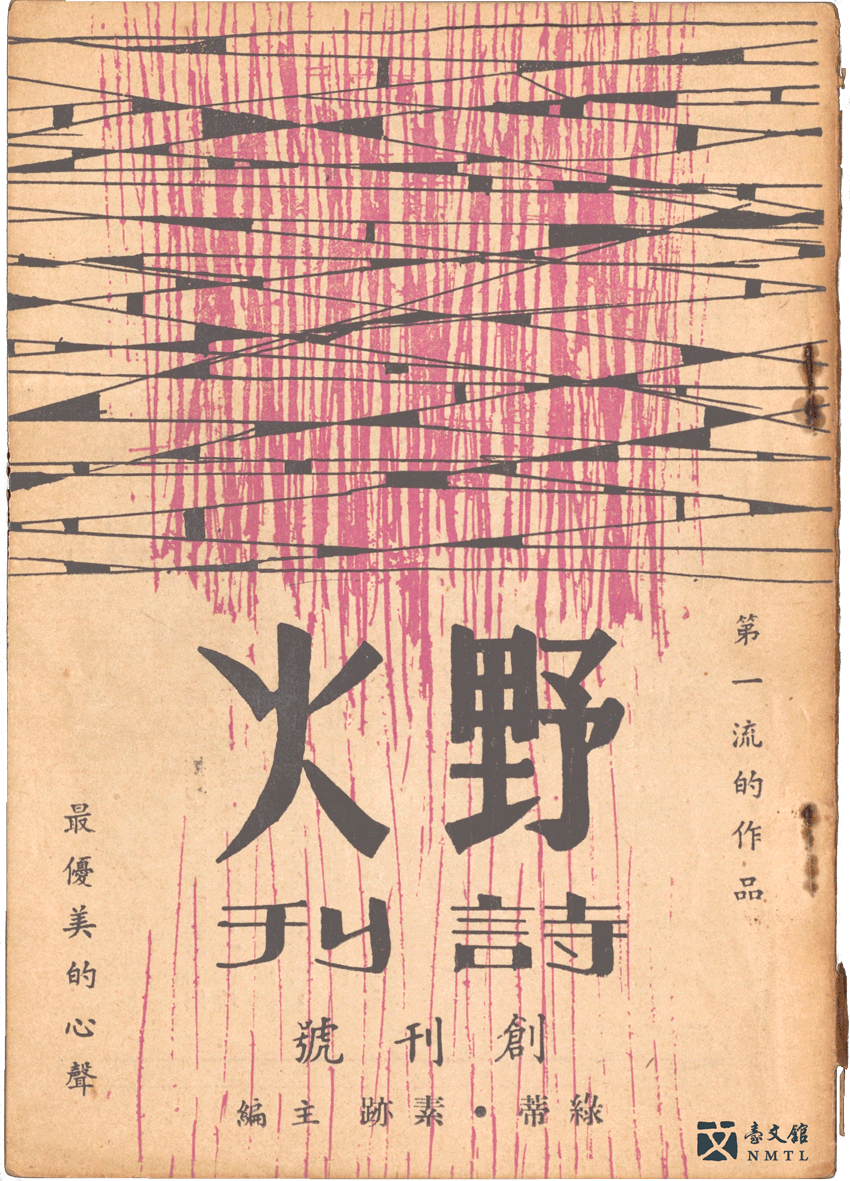
⁍ WILDFIRE POETRY (First Issue)|Taipei Wildfire Poetry Society, 1962.5.
Lu Ti, editor-in-chief; published irregularly. Discontinued in August 1962 after the fourth issue was printed. (Provided by Chen Chien-wu/ From the National Museum of Taiwan Literature permanent collection)
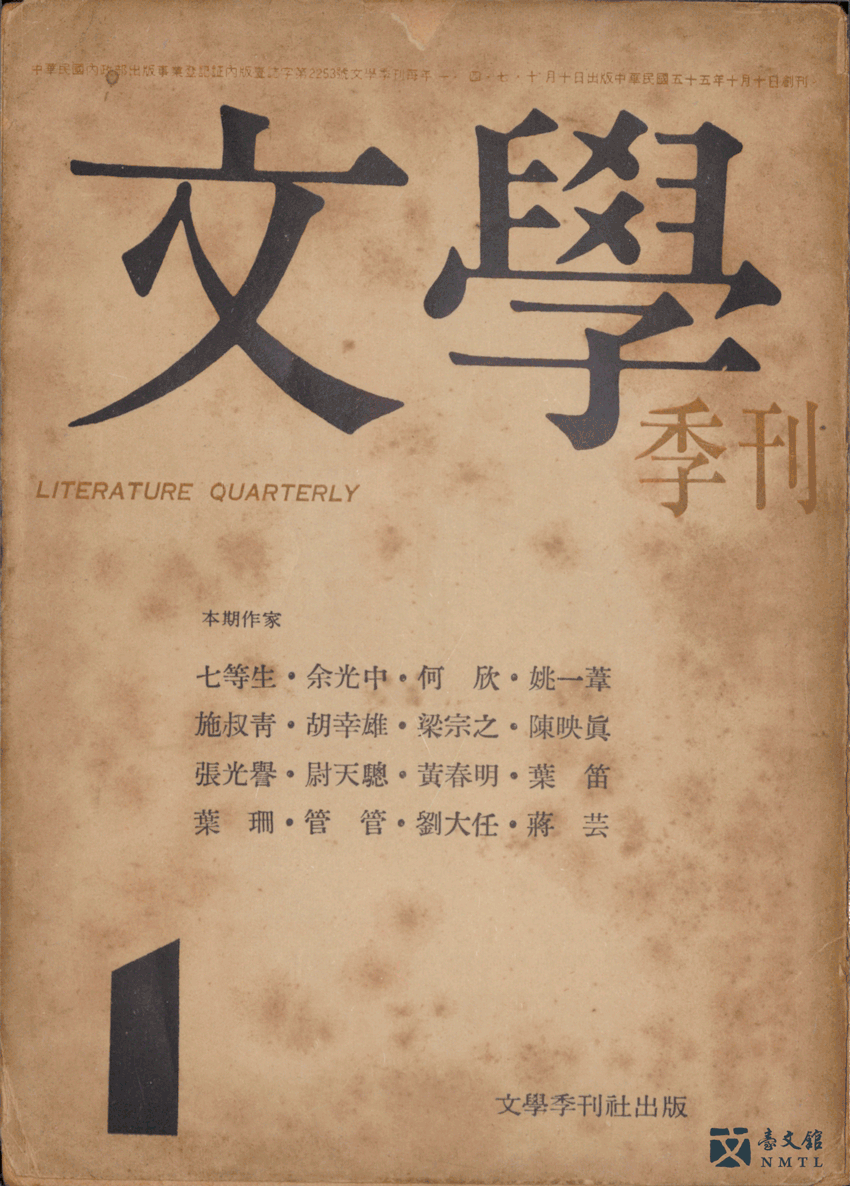
⁍ LITERATURE QUARTERLY (First Issue)|1966.10.
Published by editor-in-chief Wei Su-chiu, 10 issues of LITERATURE QUARTERLY were printed before it ceased in 1970. It featured novels by Huang Chun-ming, Chen Ying-chen, Wang Chen-ho, Chi Teng Sheng and others. After LITERATURE QUARTERLY was discontinued, other titles such as: LITERATURE BIMONTHLY, LITERATURE QUARTERLY, and SEASONAL LITERATURE were introduced. The numerous authors enriched the theory and creation of modernism and realism, as well as stimulating nativist literary debates, which had a far-reaching impact on Taiwan literature. (From the collection of the library at the National Museum of Taiwan Literature)
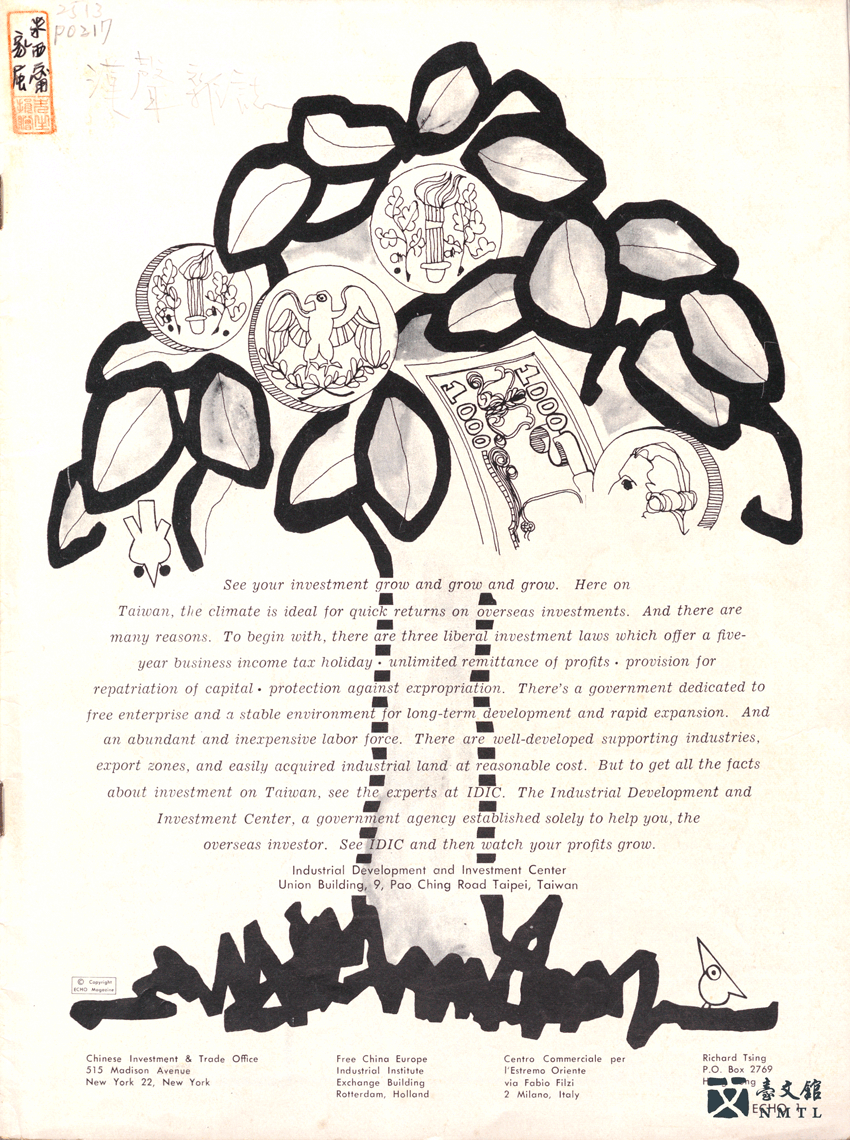
⁍ ECHO MAGAZINE (First Issue)|1978.1.
In January 1971, Huang Yong-song, Wu Mei-yun, Yao Meng-chia, and Shi Sung founded ECHO MAGAZINE with the concept of "telling all things Chinese." Through the archiving and sharing of traditional folk culture and arts, it hoped to become a leading authority in the folk culture space. The Chinese edition of ECHO MAGAZINE published its first issue in January 1987 also in an effort to preserve cultural heritage, as well as driving the development of Taiwanese reportage literature and photography. (Provided by Chu Tien-wen/ From the National Museum of Taiwan Literature permanent collection)
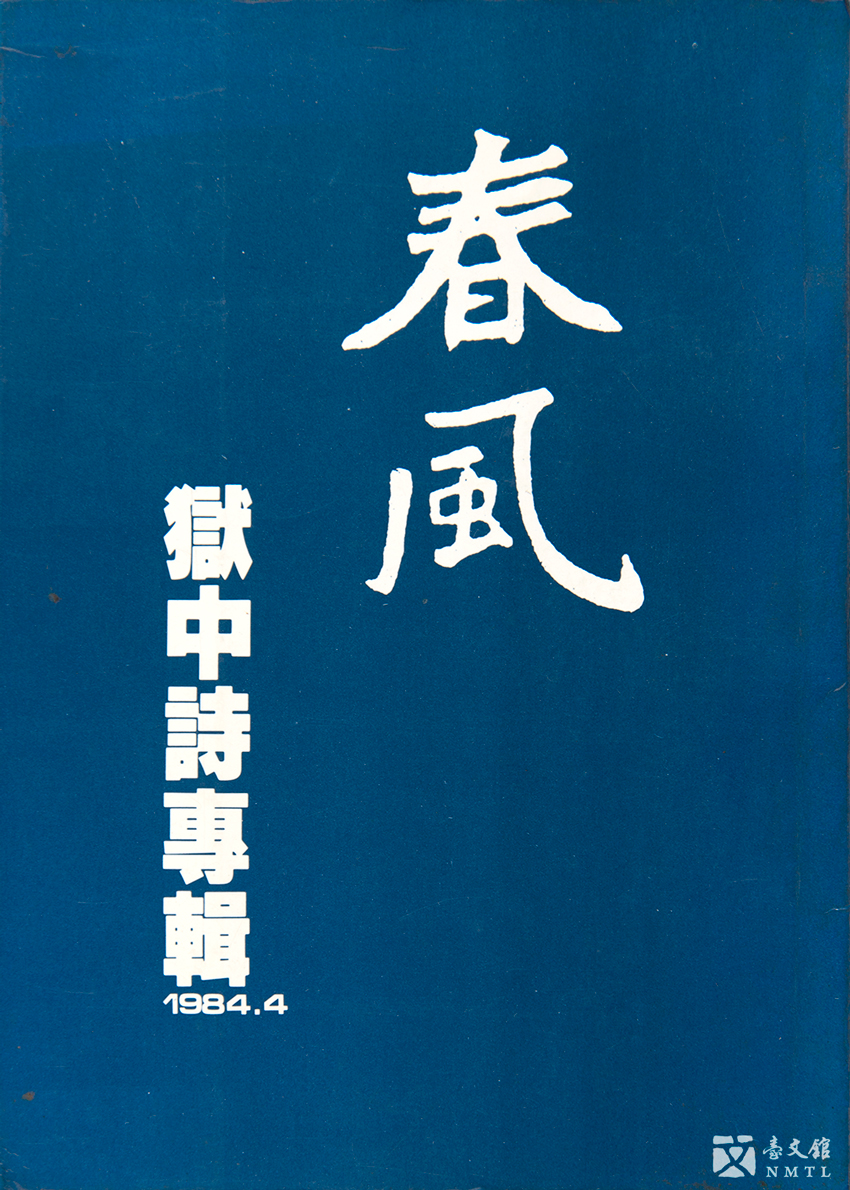
⁍ SPRING BREEZE Poetry Collection (First Issue)|Spring Breeze Poetry Society, 1984.4.
In April 1984, Yang Tu, Li Chi, Chan Che, Chung Chiao, Lin Hua-chou and others, after founding the Spring Breeze Poetry Society, introduced SPRING BREEZE. The first issue titled "Prison Poetry Album" celebrated the return of political prisoners and also those who had not returned. This was followed with themes such as: "Beautiful Stalks: Myths and Legends of Taiwan's Ethnic Minorities," "Ode to Poems Abroad," and "The Rise of Poetry: A Mainland Chinese Misty Poetry Album." Due to its distinctive leftist color, every issue of the magazine was banned from circulation, and it was discontinued later due to a lack of funds. (Provided by Yeh Chen-chen/ From the National Museum of Taiwan Literature permanent collection)
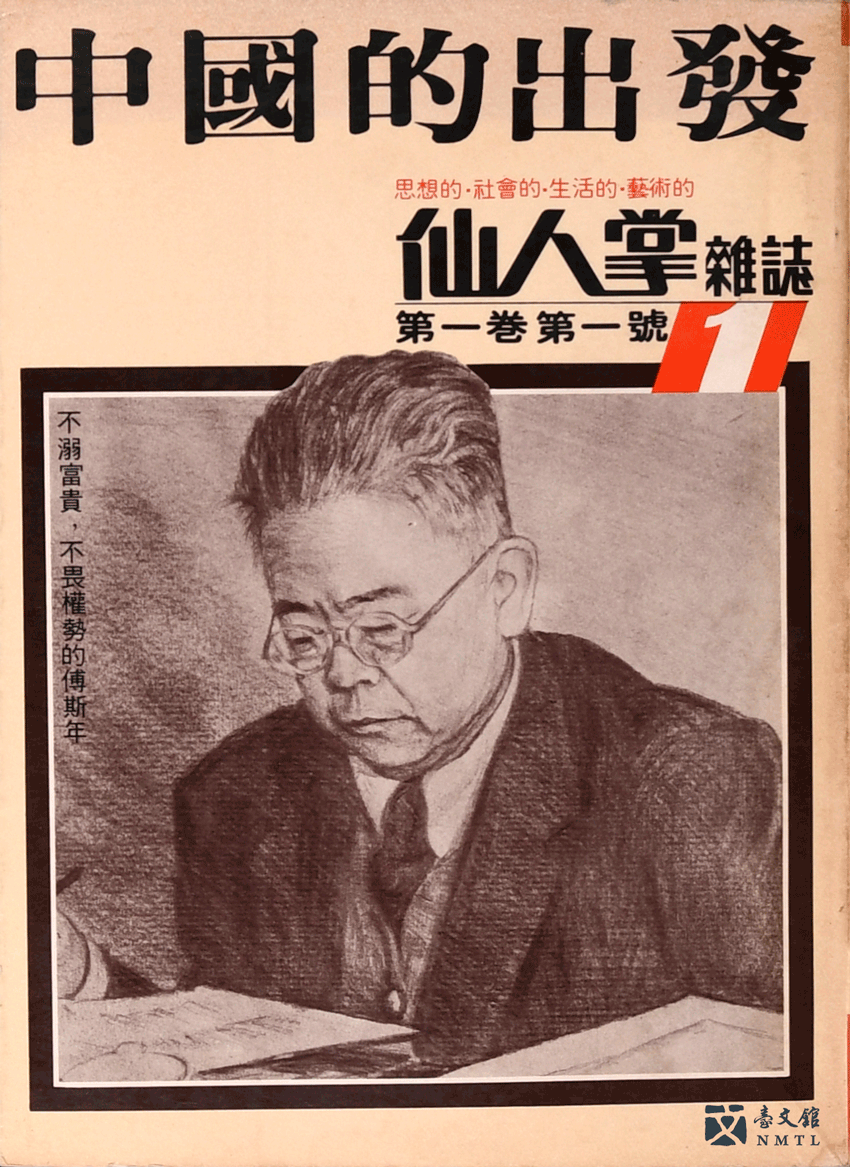
⁍ CACTUS MAGAZINE Volume 1, Issue 1|1977.3.
In March 1977 former representative of Cactus Publishing, Lin Ping-chin, founded CACTUS MAGAZINE with the first issue themed "China's Takeoff." It sparked social discussions beyond literary circles for its references to profound controversial topics. The second issue set off a nativist literary debate and attracted "unsolicited attention" from official departments. Coupled with financial constraints, CACTUS MAGAZINE ceased after its 12th issue. (Provided by Tsai Yu-ling/ From the National Museum of Taiwan Literature permanent collection)
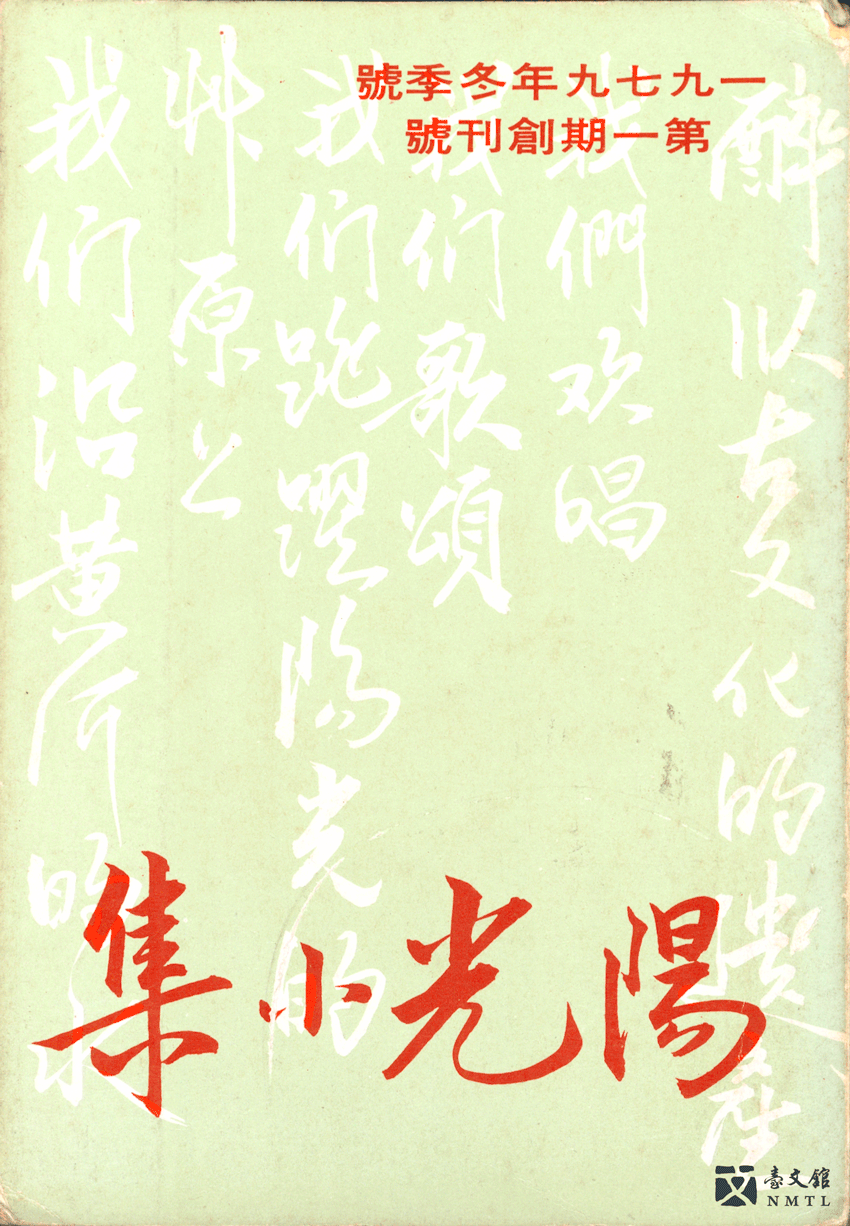
⁍ SUNSHINE COLLECTION (First Issue)|Sunshine Collection Poetry Society, 1979.12.
SUNSHINE COLLECTION was founded in Kaohsiung by members Mo Shang-chen, Xiang Yang, Chang Hsueh-ying, Chuang Hsi-chao, Li Chang-hsien, and Ku Ling, among others. Before it was discontinued in June 1984, it underwent several overhauls and published 13 issues while Taiwan was moving towards an era of democracy and rising social awareness. The publication adopted two positions: "caring about reality" and "embracing the masses" to narrow the gap between poetry and the people. (Provided by Chang Te-chung/ From the National Museum of Taiwan Literature permanent collection)
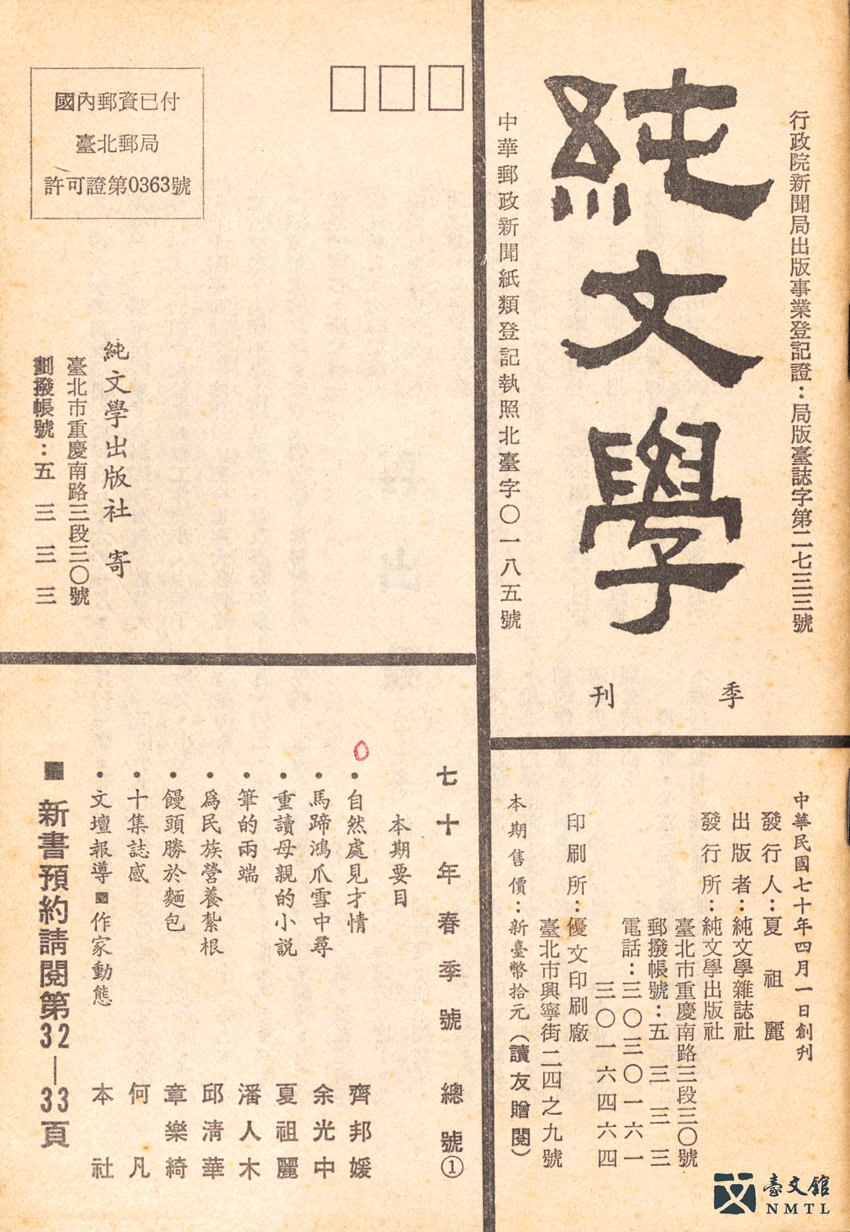
⁍ BELLES-LETTRES Quarterly (First Issue)|Belles-Lettres Publishing House, 1981.4.
10 years after BELLES-LETTRES MONTHLY was discontinued, Belles-Lettres Publishing House launched BELLES-LETTRES QUARTERLY in 1981. Although it prioritized book-based news, contents were very diverse and most contributors had also written for BELLES-LETTRES MONTHLY, for example Yu Kwang-chung, Pan Jen-mu, Chi Chun, and Ho Fan. The most notable difference was that the publisher had changed from Lin Hai-yin to her daughter Hsia Tsu-li. (Provided by Chi Chun's family/ From the National Museum of Taiwan Literature permanent collection)
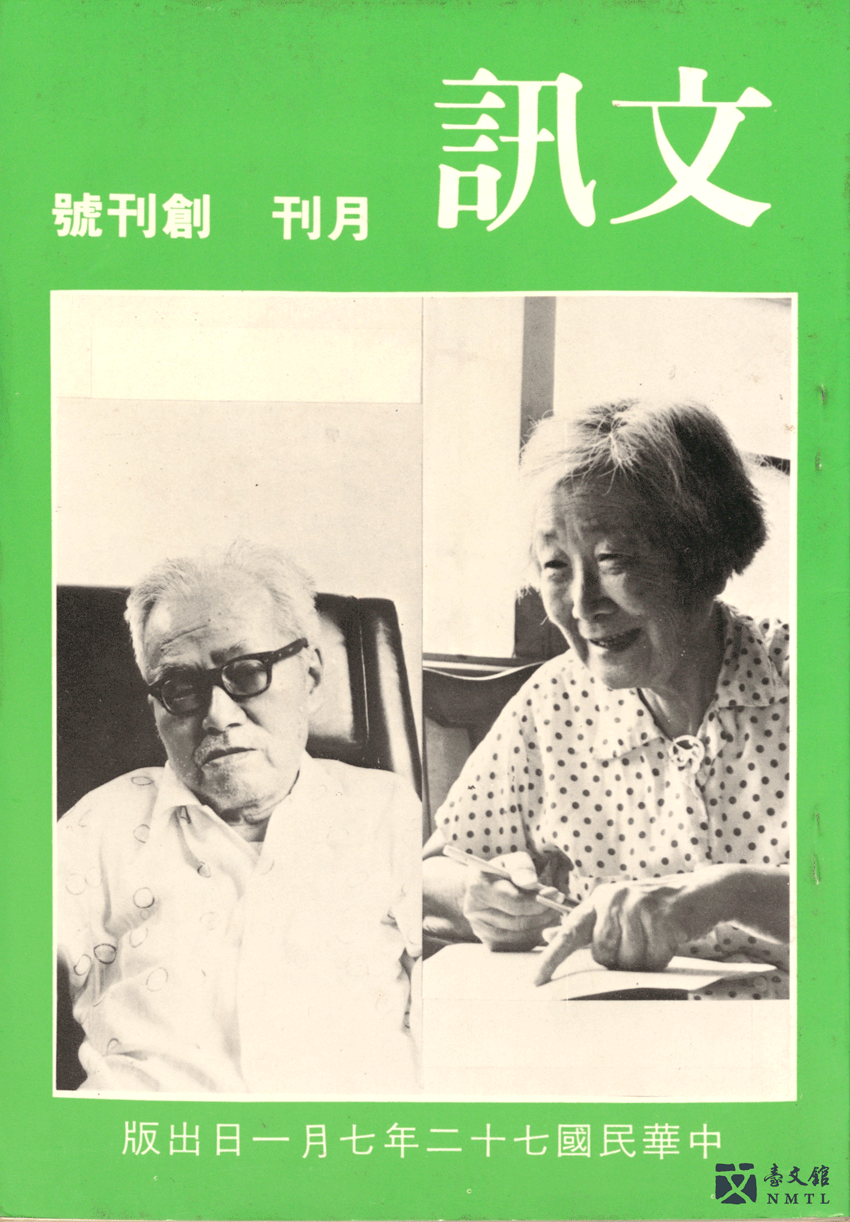
⁍ LITERARY NEWS (First Issue)|Literary News Magazine, 1983.7.
With the purpose to service the public and literary arts circle, LITERARY NEWS collected, organized, and researched historical materials to set a model for the literary review in Taiwan. The first issue featured veteran authors Su Hsueh-lin and Wang Shih-lang on the cover, and included different units like thematic columns, literary discussions, author roundups, art and literature comparisons, book recommendations, "Forest of Books," society introductions, and "Wen Yuan Duan Bo." (Provided by Lin Jui-ming/ From the National Museum of Taiwan Literature permanent collection)
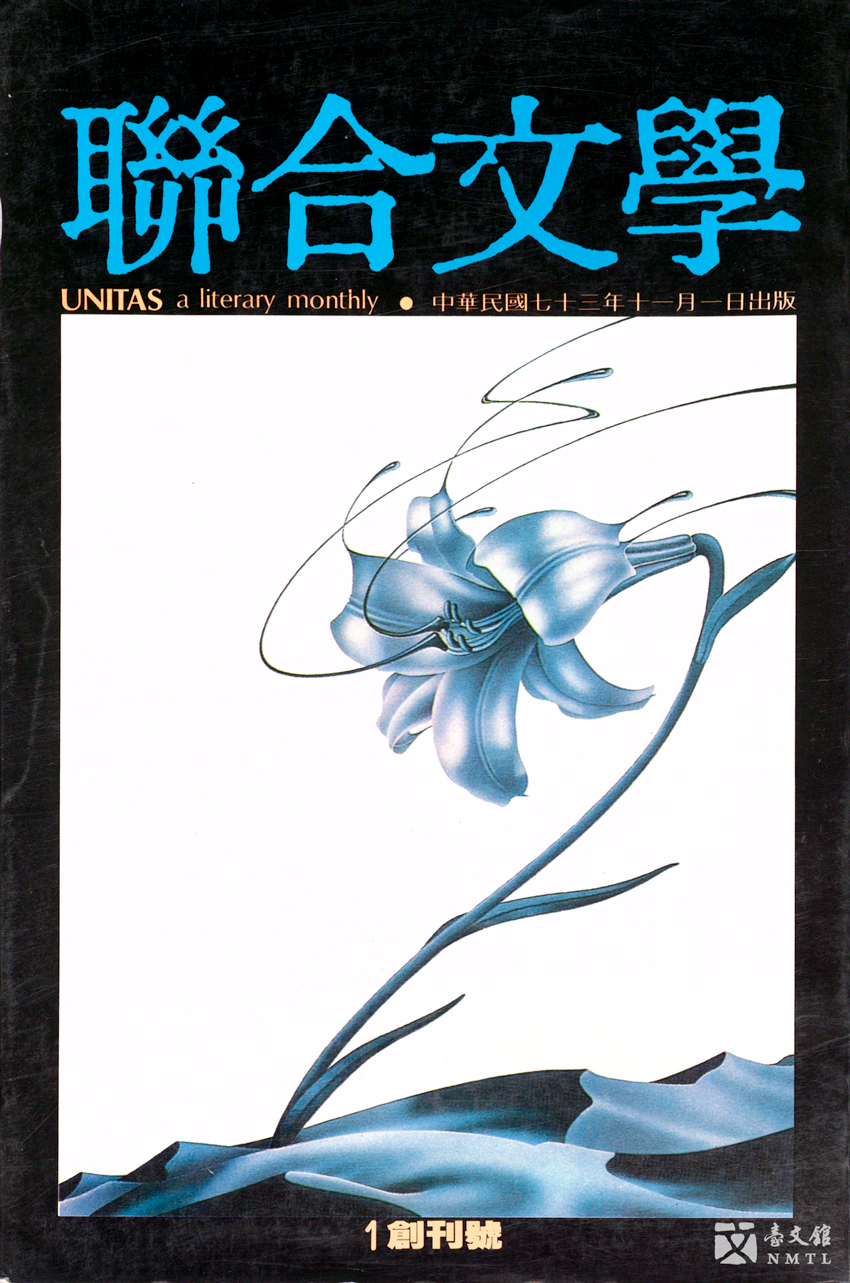
⁍ UNITAS: A LITERARY MONTHLY (First Issue)|Unitas Publishing Co., Ltd., 1984.11.
UNITAS: A LITERARY MONTHLY was founded by then chairman of United Daily News Wang Ti-wu, with Chang Bao-chin acting as publisher, Chang Hsun as president, and Lung Ying-tai as honorary publisher. It upheld that authors, readers, and editors are one, and advocated for literature to "not be a luxury for a minority, but a basic necessity for all." To reflect the interests and habits of a new generation of readers, the publication has been refreshed multiple times in recent years and covering wide-ranging topics that are lively and down-to-earth. (Provided by Lee Kuei-shien/ From the National Museum of Taiwan Literature permanent collection)
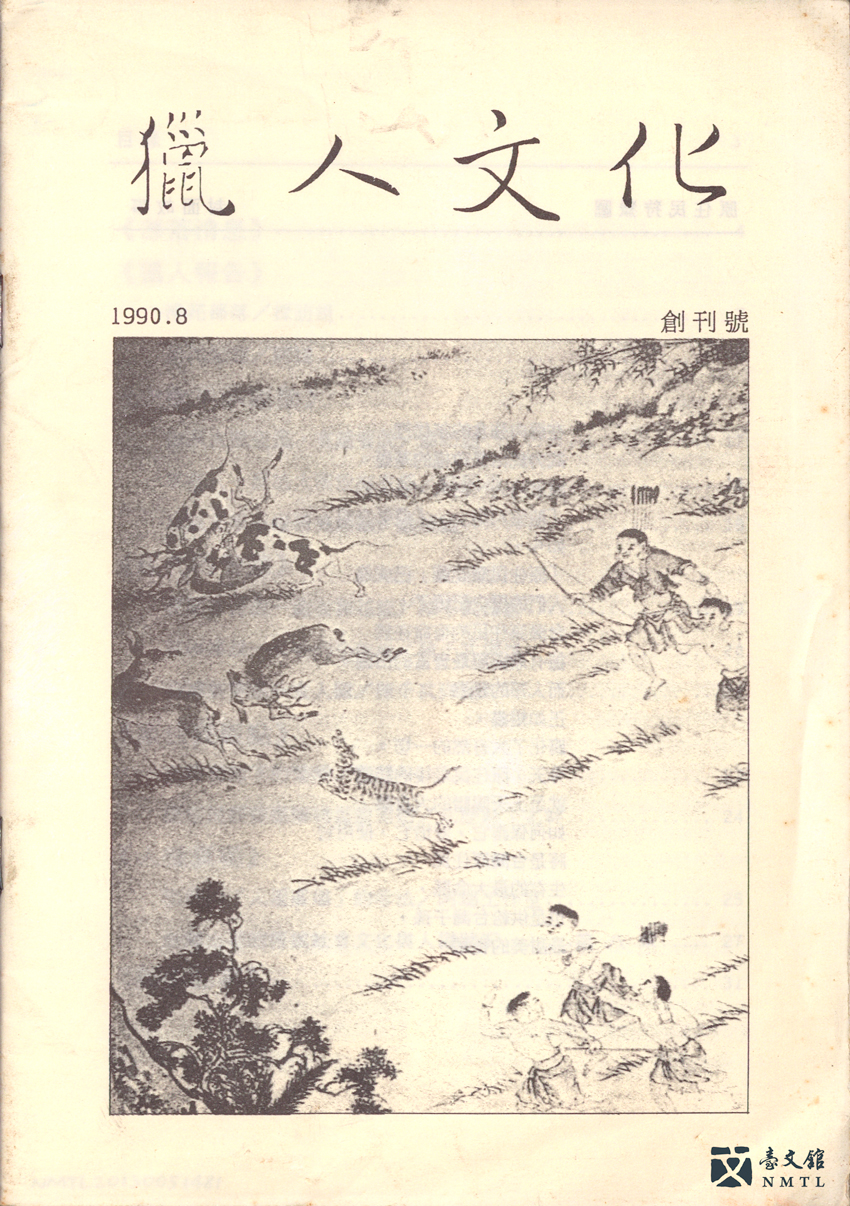
⁍ HUNTER CULTURE Magazine (First Issue)|1990.8.
Co-created by Atayal author Walis Nokan and Paiwan author Liglav A-wu, HUNTER CULTURE printed a total of 18 issues before ceasing in June 1992. Covering the overall spiritual and cultural aspects of Taiwan's indigenous people, topics spanned indigenous literature, oral literature and perspectives, hunter reports, introductions to cultural relics, and more. It prioritized interviews of different tribes to reveal their true plights, striving for the restoration of indigenous culture. (Provided by Chen Chien-wu/ From the National Museum of Taiwan Literature permanent collection)
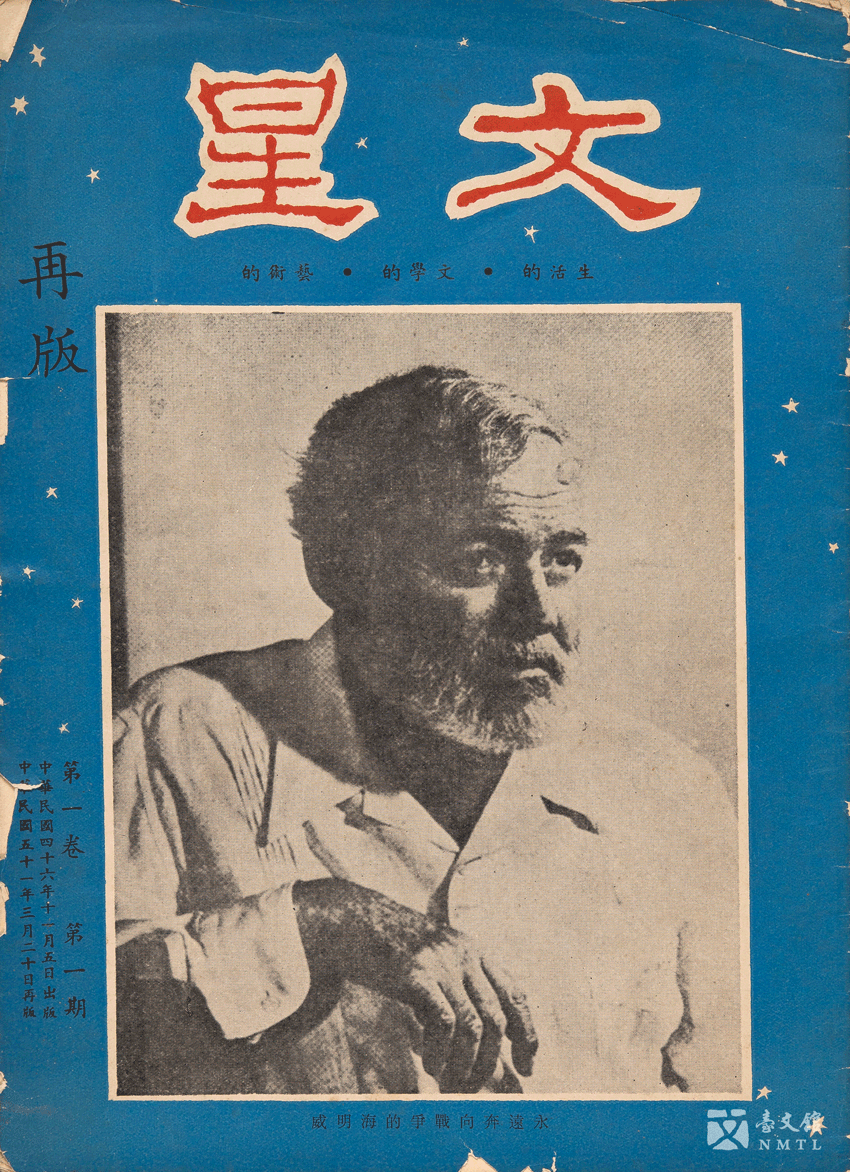
⁍ APOLLO MAGAZINE, Volume 1, Issue 1|Edited by Wen Xing Editorial Board, 1957.11.
APOLLO MAGAZINE was conceptualized by Wenxin Bookstore founder Hsiao Meng-neng initially with the theme of "living, literary and artistic." Later, after being inspired by the belief that "life is guided by knowledge", Hsiao pivoted editorial direction towards the "ideological, living, and artistic," advocating new literature and passing on ideological trends. Contents spanned literary reviews, modern poetry, novels, biographies, and travel diaries, among others. (Provided by Lin Chin-peng's family/ From the National Museum of Taiwan Literature permanent collection)
Legends, printed pages after pages - the bloom of arts publishers
In 1952, Wenxing Bookstore was founded. It sold academic books and led a trend of prose poetry collections. In 1963, WENXING COLLECTIONS started the trend of book series. Subsequently, there were THE XINCHAO SERIES published by Zhiwen Publishing House, THE BUFFALO SERIES by Buffalo Book Co., THE REN REN SERIES by The Commercial Press, and THE SANMIN SERIES by Sanmin Bookstore. These series were printed in the format of quarto books, making it easy for reading and the dissemination of knowledge. Under an authoritarian regime, publishers strove to seek the clash of ideas and hoped to break free from all sorts of restrictions. By awakening the suppressed needs of society, these sparks led to a surge of new ideas and commercial profit.
There was a famous saying in Taiwan's literary world in the 1970s: "Submit your articles to the two major newspapers and look for the five small publishers to publish your books." The so-called "five small publishers" refers to the five "pure literature" publishers whose quality and sales were both excellent: "Belles-Lettres Publishing House," founded by Lin Hai-yin, "Vast Plain Publishing House," founded by Yao I-ying, "Erya Publishing," founded by Yin-ti, "Hung-fan Bookstore," founded by Ya Hsien, Yang Mu, Shen Yen-shih, and Yeh Pu-jung, and "Chiu Ko Publishing Co.,Ltd," founded by Tsai Wen-fu. These five publishers dominated the market while the owners were privately very close. They formed an influential circle in the publishing industry and the reputed name "Five Small Literature Publishers" was soon known.
The 1970s were also the time when the first wave of local publishers appeared. With increased education levels and an expanded market, the publishing industry transformed from being dominated by a minority of publishers into having multiple influential publishers at the same time. The most eye-catching ones were the young publishers who brought a breath of fresh air to Taiwan's publishing industry, e.g., Shen Teng-en's Vista Publishing, Wang Jung-wen's Yuan-Liou, Huang Yong-song's Han Sheng, and Lai A-sheng's Lauréat Publications.
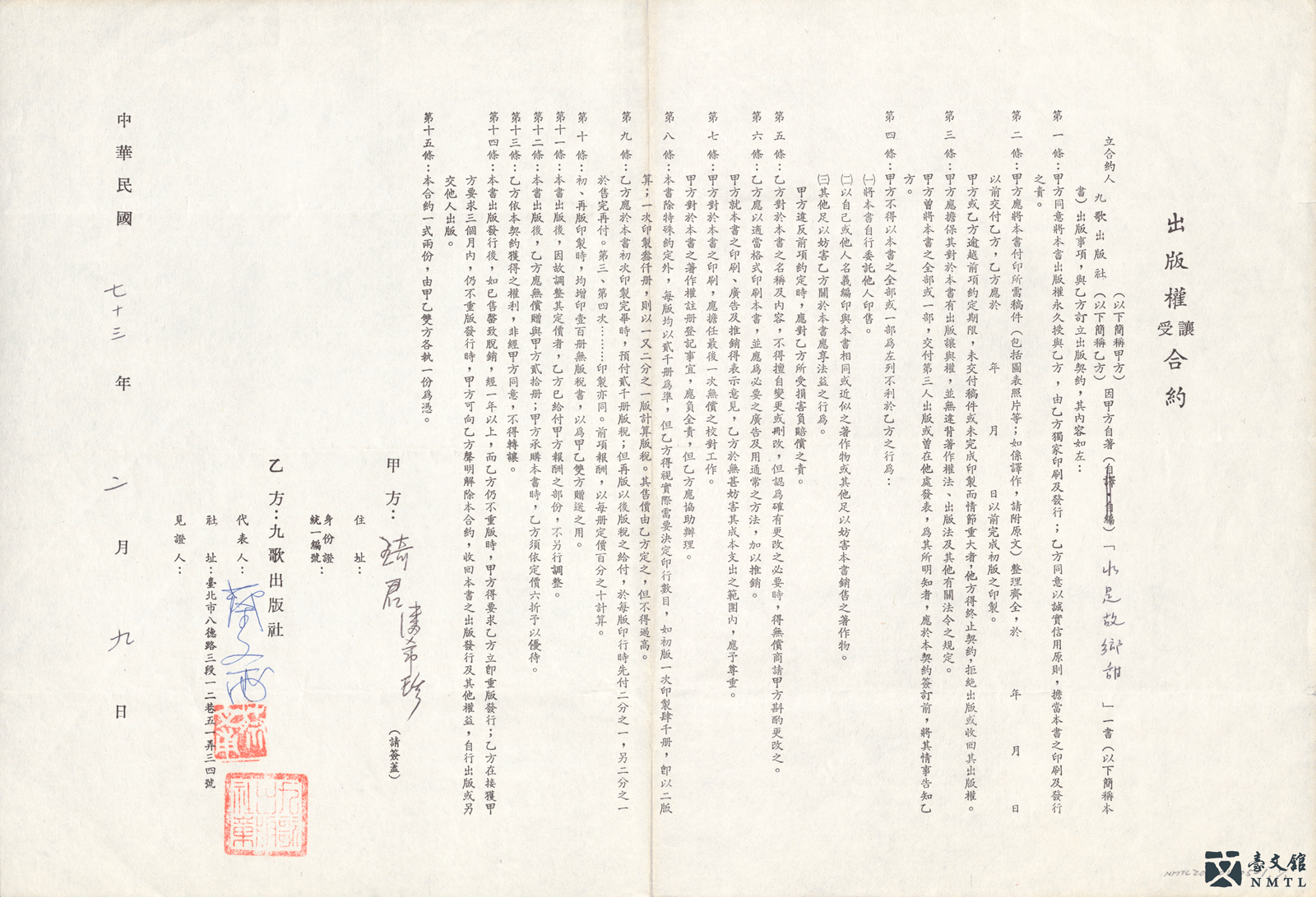
⁍ Grant of Publishing Rights Contract: SWEET WATER OF HOME|1984.2.9.
SWEET WATER OF HOME is Chi Chun's second prose work issued by Chiu Ko Publishing Co.,Ltd, the first being RIDE WITH ME in 1979. This contract between the author and publisher enforced the rights and obligations of both parties as well as payment method of royalties. (Provided by Chi Chun's family/ From the National Museum of Taiwan Literature permanent collection)
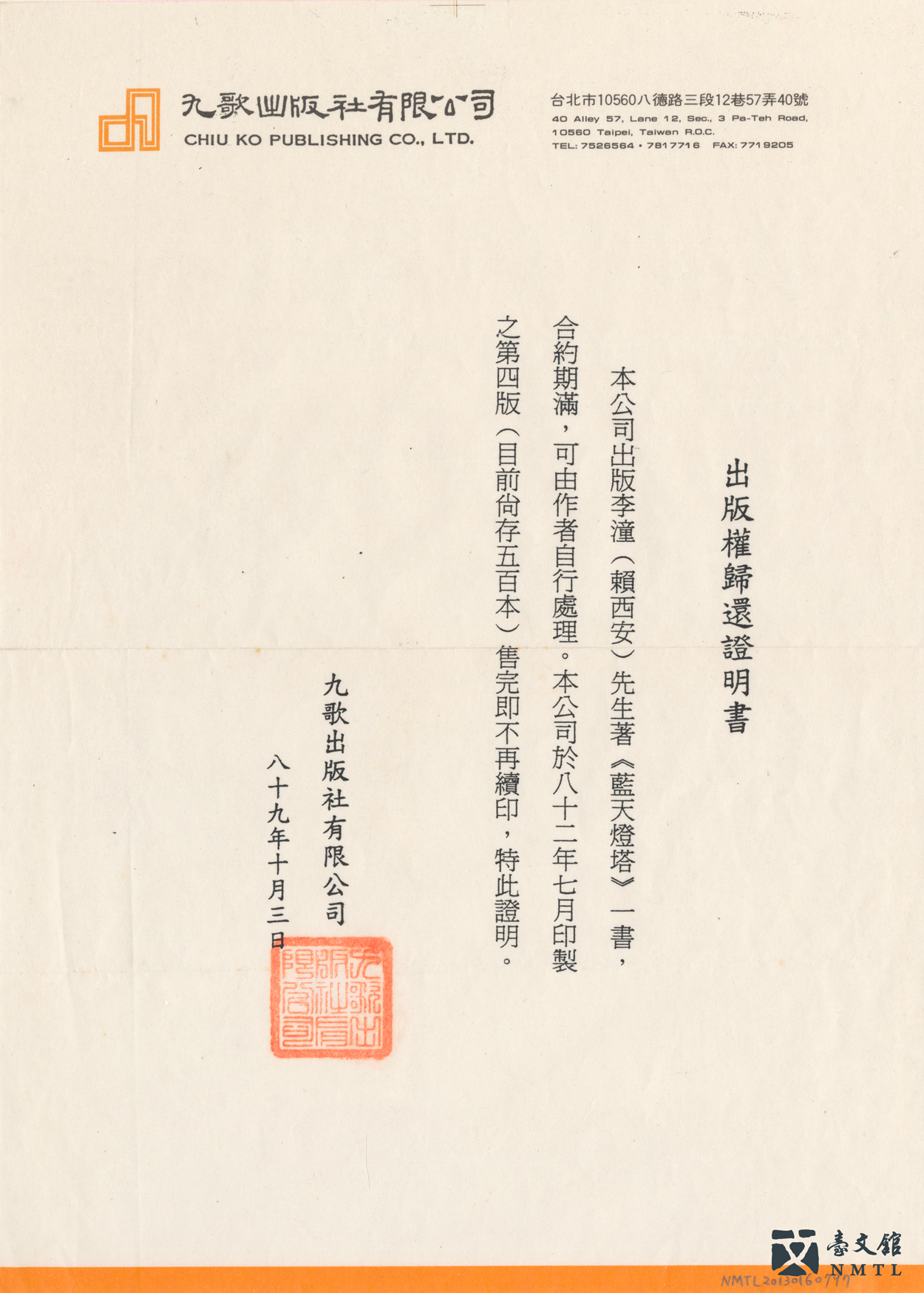
⁍ Certificate of Return of Publishing Rights, Chiu Ko Publishing Co.,Ltd|2000.10.3.
Aside from the "Chiu Ko Archives," Chiu Ko Publishing Co.,Ltd has a "Chiu Ko Children's Library" that encouraged the creation of children's literature. In 1991 Li Tung's BLUE SKY LIGHTHOUSE was named the best children's book by the CHINA TIMES review section and received accolades at the fourth Taiwanese Children's Literary Awards in the literature category. After the grant of rights contract expired in 2000, the publishing company returned the copyrights to the author. (Provided by Chu Chien-tai/ From the National Museum of Taiwan Literature permanent collection)
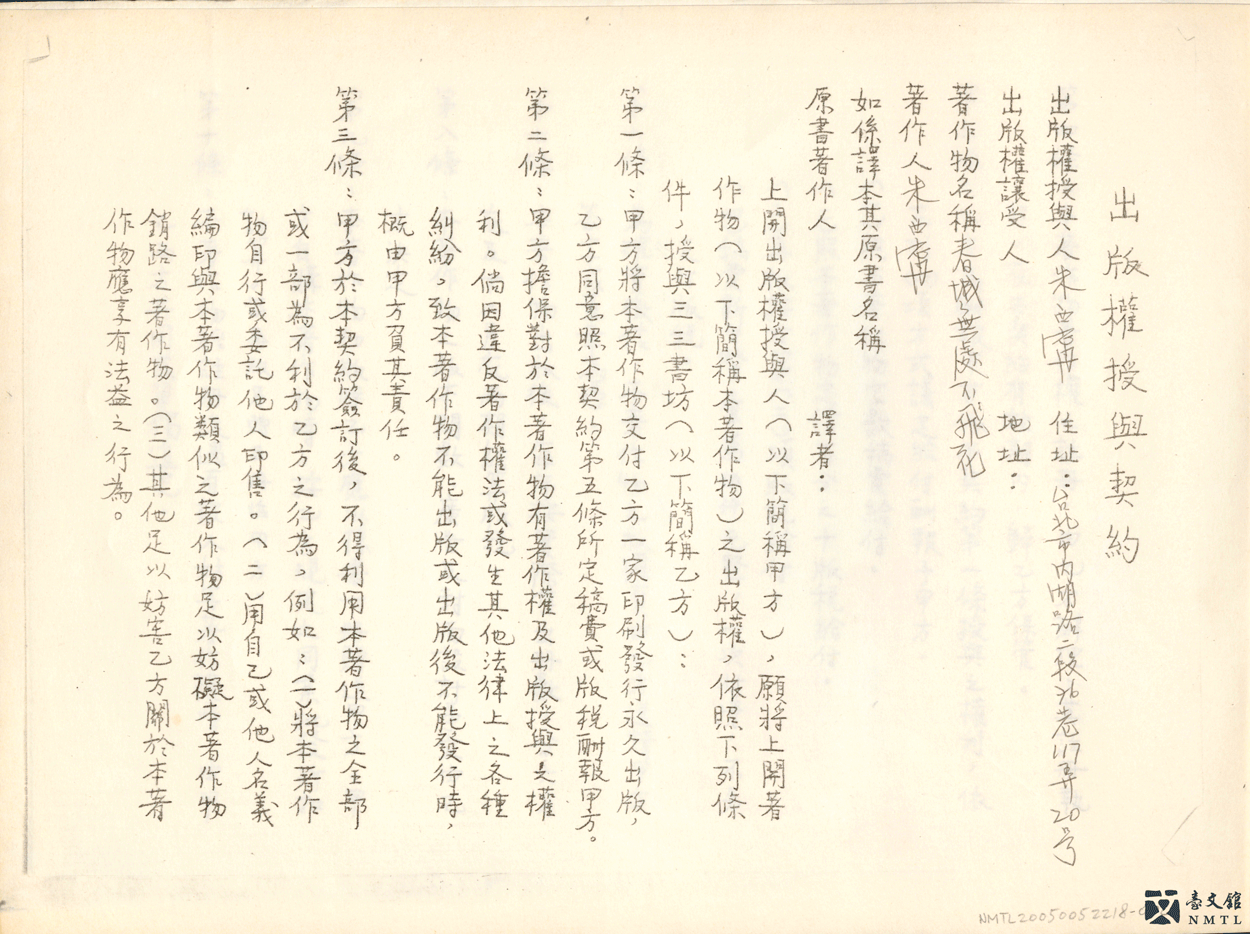
⁍ Grant of Publishing Rights Contract: EVERYWHERE ARE BLOOMS IN SPRING|1979.
The second novel series by Chu Hsi-ning, EVERYWHERE ARE BLOOMS IN SPRING paints the intricate thoughts and dilemmas of women through the dominant imagery of different flowers and plants. Composed of nine novels including "Yesterday, White Hexagon" and "Fiery Knot on The Phoenix Tree," it was printed by San-san Bookstore in October 1975. This exhibit is the grant of rights contract signed between Chu and the publisher. (Provided by Chu Tien-wen/ From the National Museum of Taiwan Literature permanent collection)
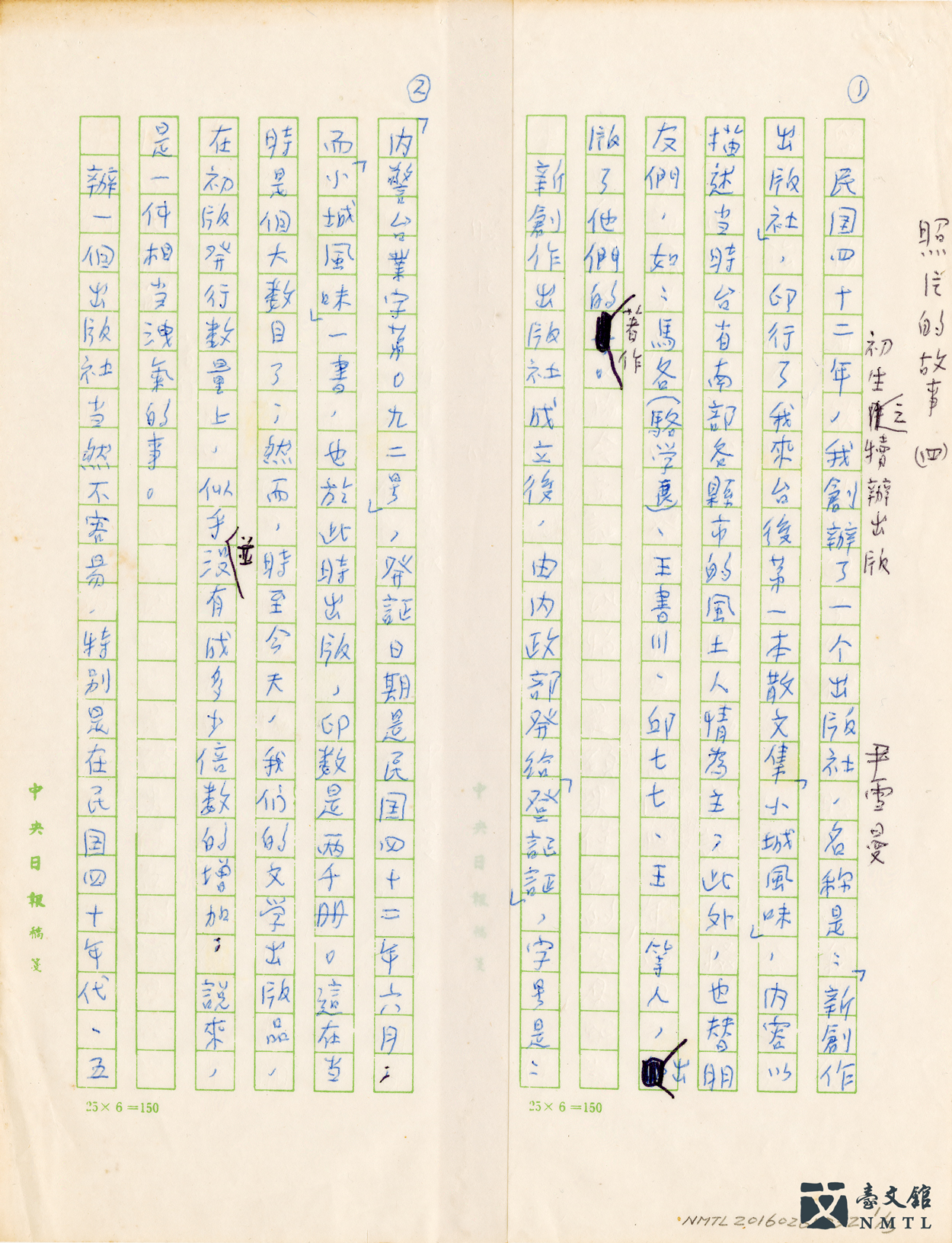
⁍ "A Newborn Calf in Publishing" (Manuscript), Yin Hsueh-man|1997.
In 1953 Yin Hsueh-man, Wang Shu-chuan, and Lo Hsueh-liang together formed the New Creation Press to publish art and literature books and periodicals. It soon issued its first collection of prose, SMALL TOWN FLAVOR, which reminisced the fearlessness – "just like a newborn calf unafraid of the tiger" – that was needed to set foot in the publishing world during the period of White Terror martial law. (Provided by Fang Ho/ From the National Museum of Taiwan Literature permanent collection)
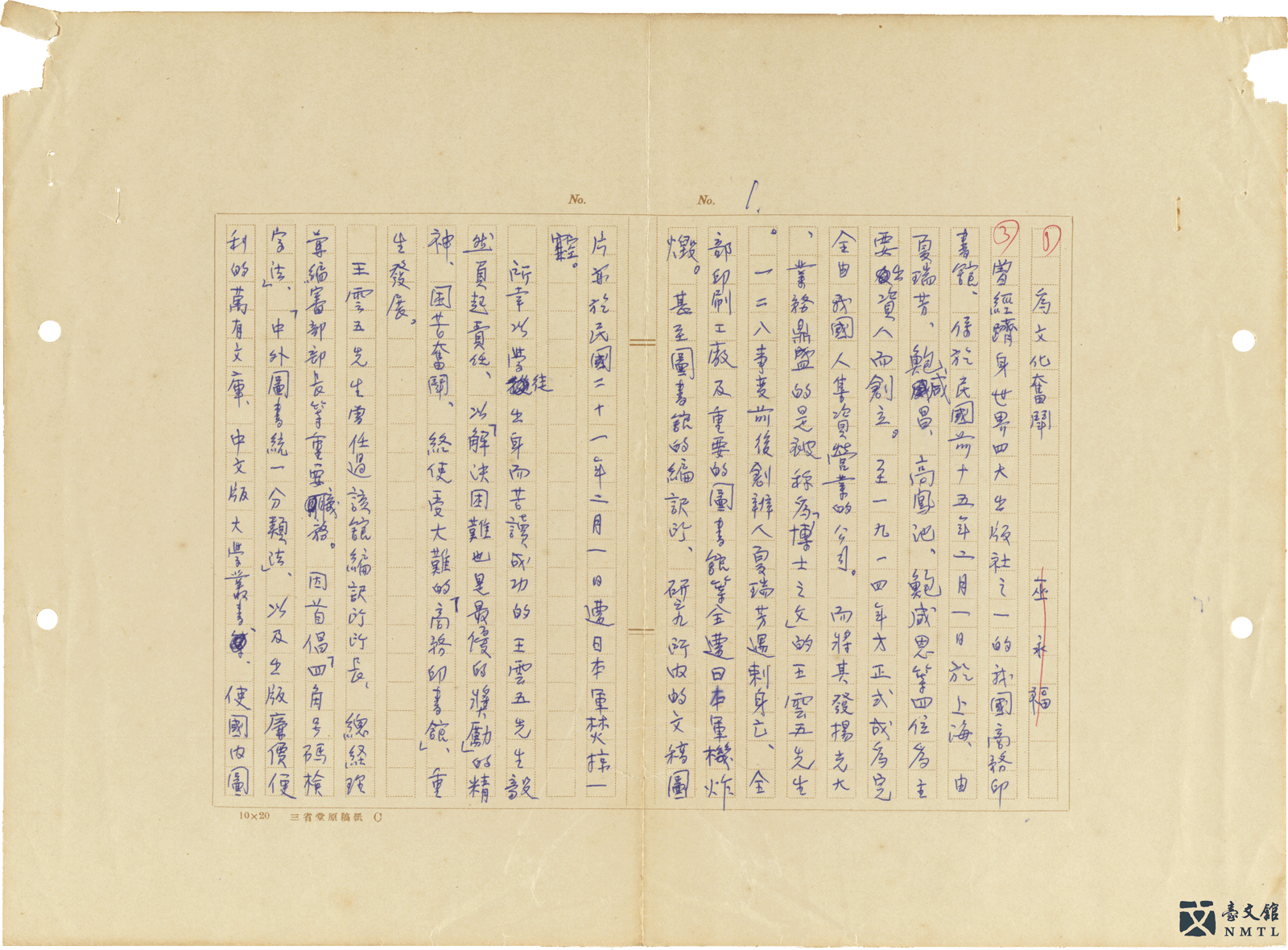
⁍ "Strive for Culture" (Manuscript), Wu Yung-fu
This article mainly introduces the "Father of Doctorates" Mr. Wang Yun-wu and how he steered The Commercial Press, which was established in Shanghai in 1897, and, through difficult times, eventually became the most important publishing company in the world. (Provided by Shen Ming-chin/ From the National Museum of Taiwan Literature permanent collection)
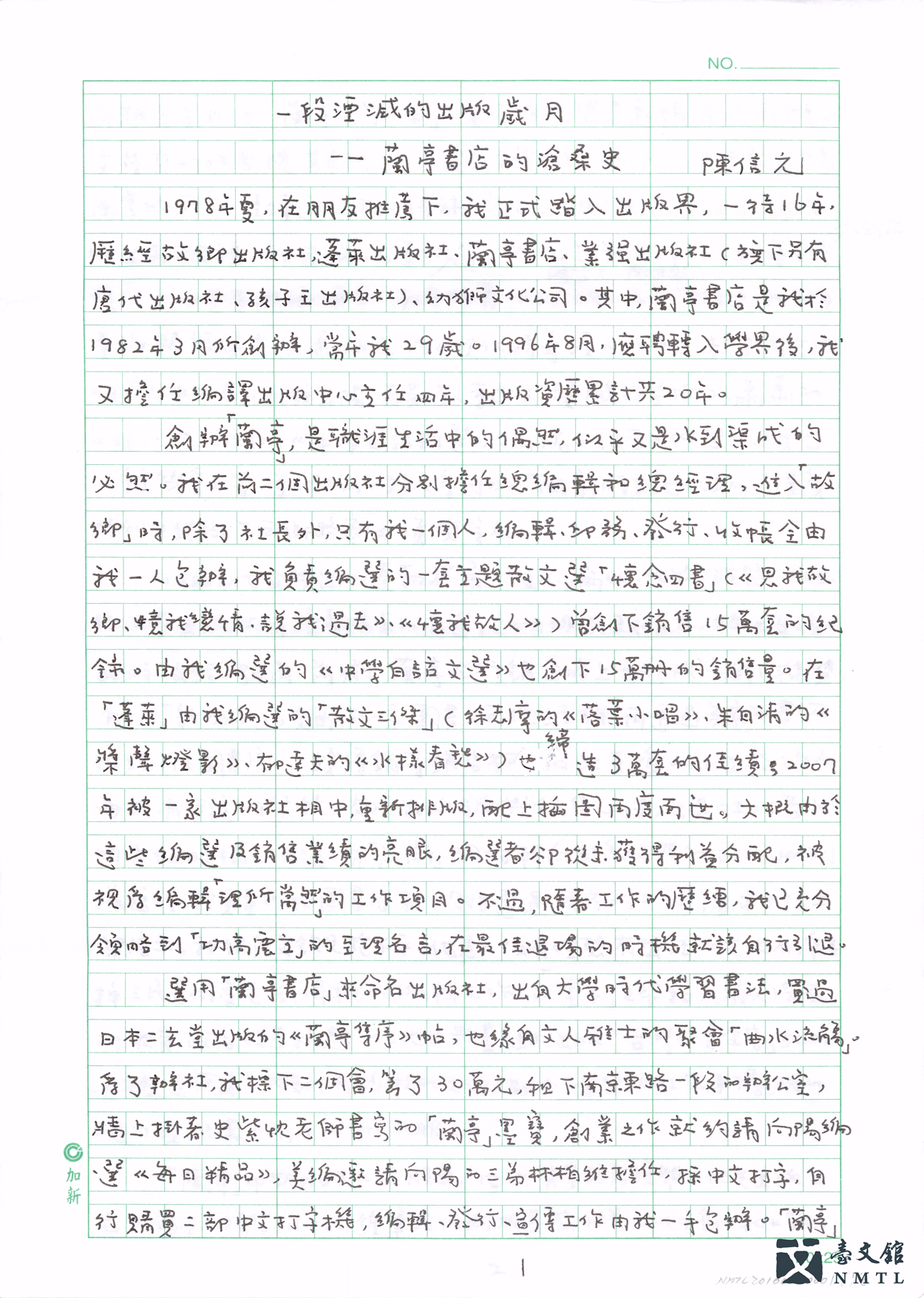
⁍ "A Bygone Publishing Era: The History of Lanting Bookstore Marked by Vicissitude" (Manuscript), Chen Hsin-yuan|2015.5.
Chen Hsin-yuan first entered the publishing world in the summer of 1978, and worked at Hometown Press, Penglai Press, Lanting Bookstore, Yeqiang Press, and Youth Cultural Enterprise Co., Ltd., among which, Lanting Bookstore was founded by himself in 1982 at the age of 29. This manuscript details his fateful journey from founding and prosperity to decline and final demise, offering readers a closer look into Taiwan's booming publishing industry at the time. (Provided by Editing and Publishing Plan for ANTHOLOGY OF TAIWAN LITERATURE AND HISTORY Volume 5, Research and Archive Team/ From the National Museum of Taiwan Literature permanent collection)
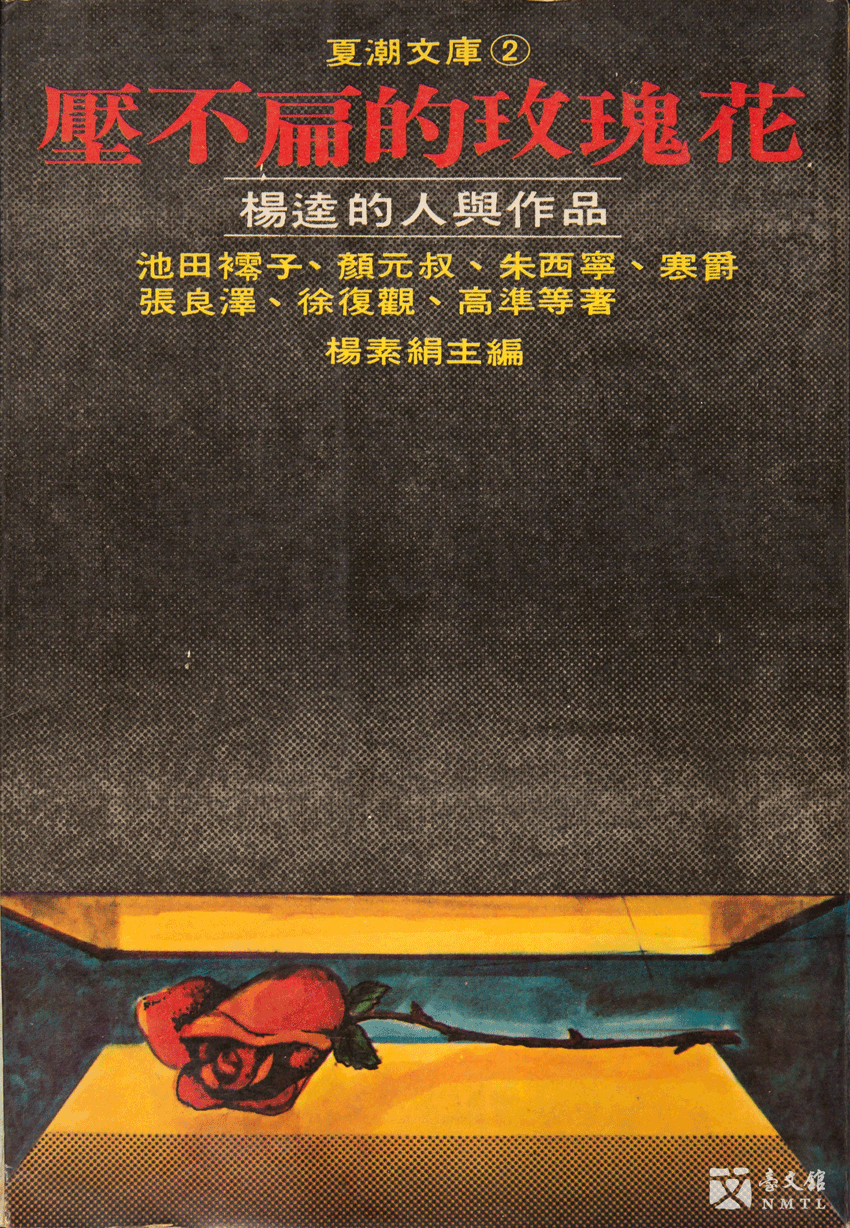
⁍ THE ROSES THAT CANNOT BE FLATTENED: YANG KUEI AND HIS WORKS, edited by Yang Su-chuan|Hui Huang Press, Taipei, 1976.10.
Yang Kuei's daughter Yang Su-chuan edited this book in celebration of her father's 71st birthday. A compiled selection of more than ten articles by authors including Yan Yuan-shu, Hsu Fu-kuan, and Chang Liang-tse comment on Yang Kuei's life and his works. Printed by Hui Huang Press, it was included in the Hsia Chao Archives 2. At the same time, SHEEP'S HEAD ESSAYS were published in Hsia Chao Archives 3. (Provided by Huang Te-shih/ From the National Museum of Taiwan Literature permanent collection)
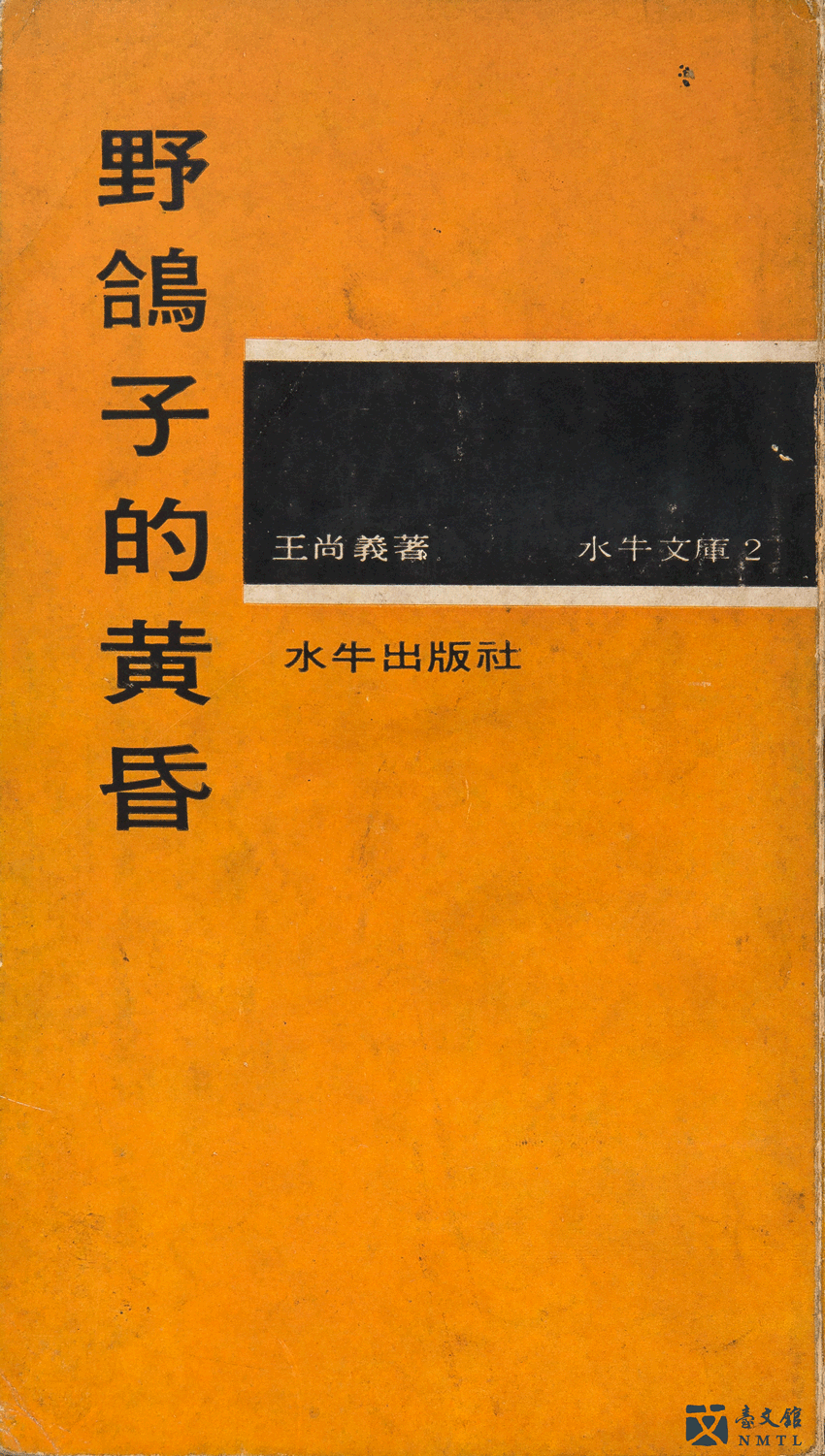
⁍ PIGEONS AT DUSK, Wang Shang-yi|Buffalo Book Co., Taipei, 1967.11.
In 1966, Peng Cheng-huang and his seven other high school classmates, who were also born in 1937, together established "Buffalo Book Co." PIGEONS AT DUSK was a representative work that helped them start gaining traction. The writer, Wang Shang-yi, passed away at the age of 26 due to illness. This book includes his manuscripts that fully showcase the distress among young people at the time. In addition, Buffalo also took over the books left by Wenxin Bookstore and Cactus Publishing after they were closed. The publisher had a profound influence on the dissemination of cultural trends in Taiwan. (Provided by Lin Chin-peng's family/ From the National Museum of Taiwan Literature permanent collection)
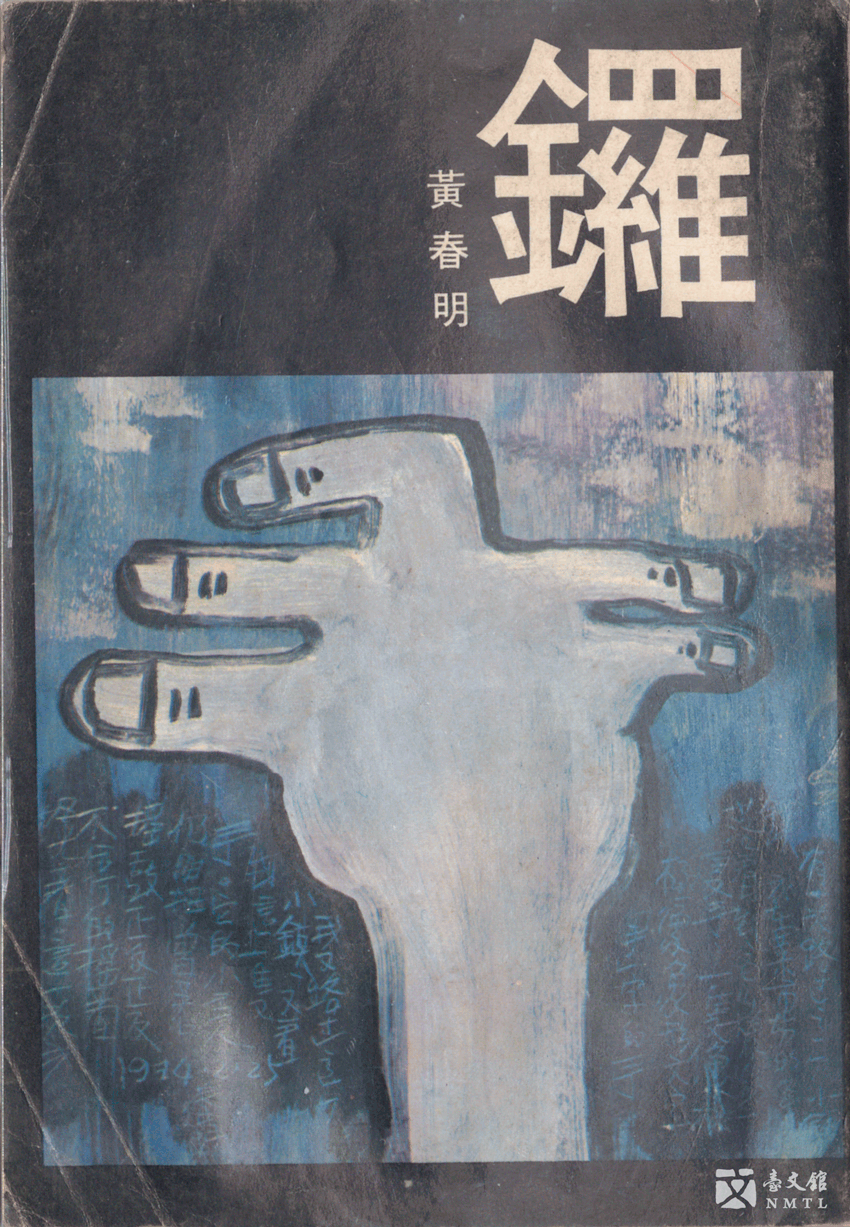
⁍ THE GONG, Huang Chun-ming|Vista Publishing, Taipei, 1974.3.
Vista Publishing was co-founded by Shen Teng-en, Teng Wei-chen, and Wang Jung-wen in 1974. THE GONG is Vista's debut project and also Huang Chun-ming's first work. Comprising five novels: "The Gong," "Gang Gengbo's Twilight," "Ah-ban And The Cop," "The Two Signpainters," and "His Son's Big Doll," it solidified Huang's status as a nativist literature author. (From the collection of the library at the National Museum of Taiwan Literature)
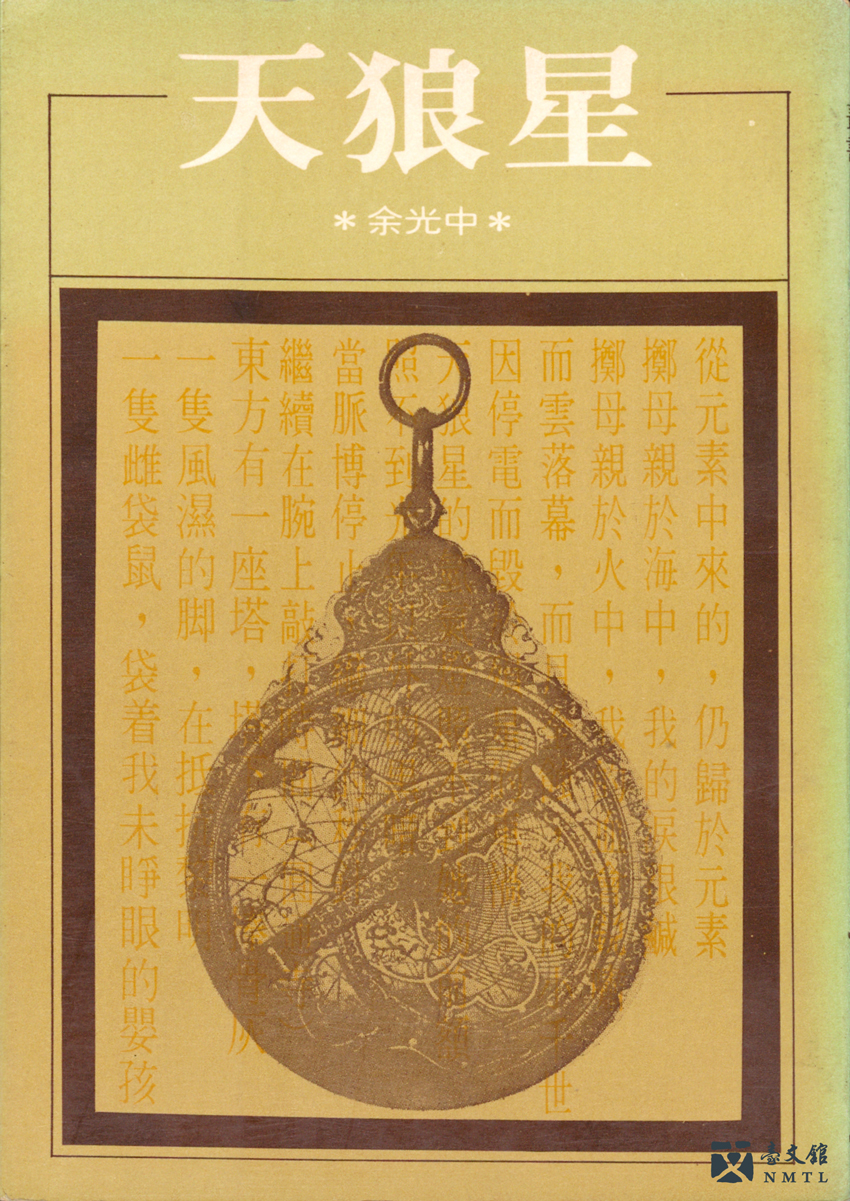
⁍ SIRIUS, Yu Kwang-chung|Hung-fan Bookstore, Taipei, 1976.8.
In 1976, Yang Mu, Ya Hsien, Yeh Pu-jung, and Shen Yen-shih established the eponymous Hung-fan Bookstore, whose name "Hung-fan" signifies "The Great Laws" after referencing SHANG SHU, one of the Five Classics of ancient Chinese literature. Hung Fan released its first batch of creative works on August 25th of the same year, and Yu Kwang-chung's SIRIUS ranked in first place in the Hung Fan Literature Series. One of the bookstore's bestsellers, this exhibited volume features Yu's past works: "Youth Walk," "Dadu Mountain," "Melancholic Rhapsody," and both old and new versions of SIRIUS. (Provided by Chang Te-chung/ From the National Museum of Taiwan Literature permanent collection)
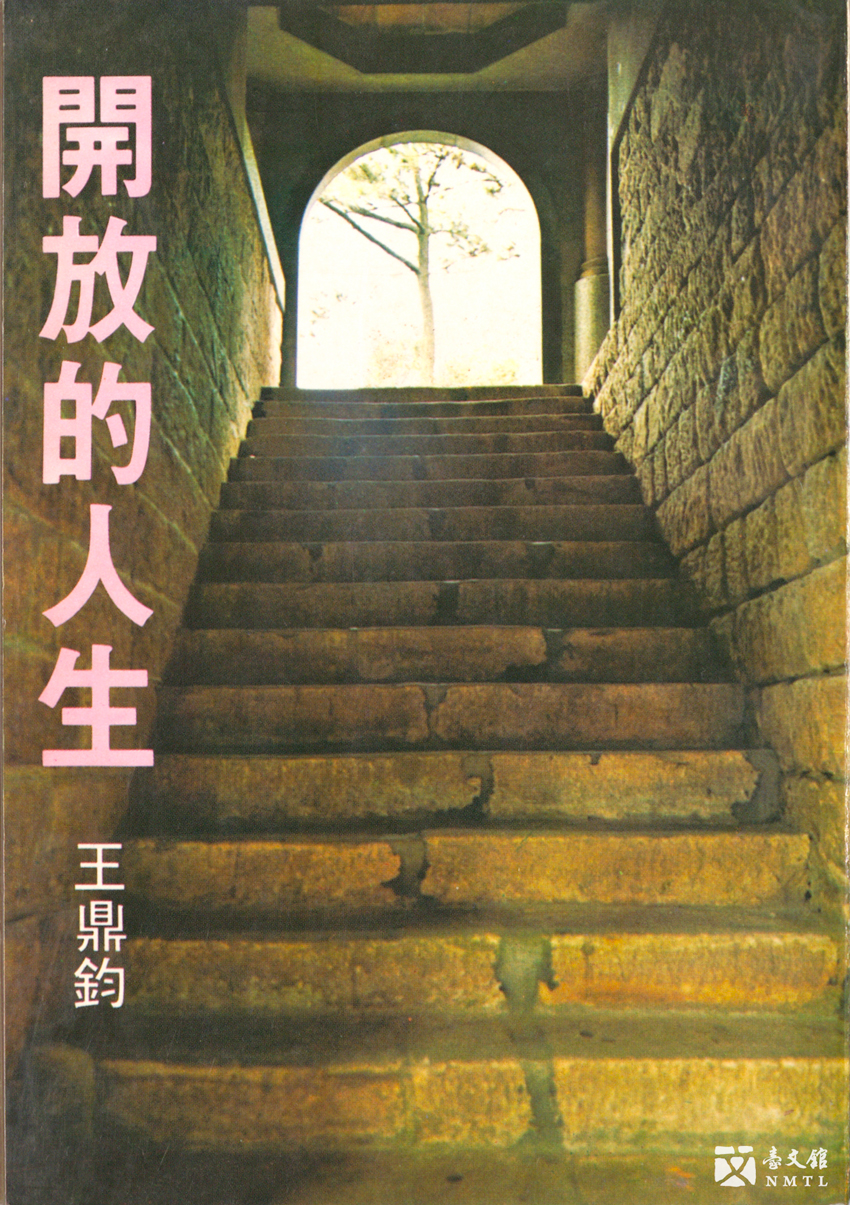
⁍ A LIBERAL LIFE, Wang Ting-chun|Erya Publishing, Taipei, 1978.7 (1975 first edition).
With the fervent support of Chien Ching-hui, Ching Hsiang and others, Erya Publishing was founded by Yin-ti on July 20, 1975. At that time Wang Ting-chun's column GOLDEN ELIXIR OF LIFE in CHUNGHWA NEWSPAPER was immensely popular. While planning for Erya, Yin Ti hoped to collect the column articles and publish them altogether. In the end, Wang gave Yin Ti the publishing rights and Yin Ti renamed it A LIBERAL LIFE. It was Erya's first book and very well received. (Provided by Wang Chia-cheng/ From the National Museum of Taiwan Literature permanent collection)
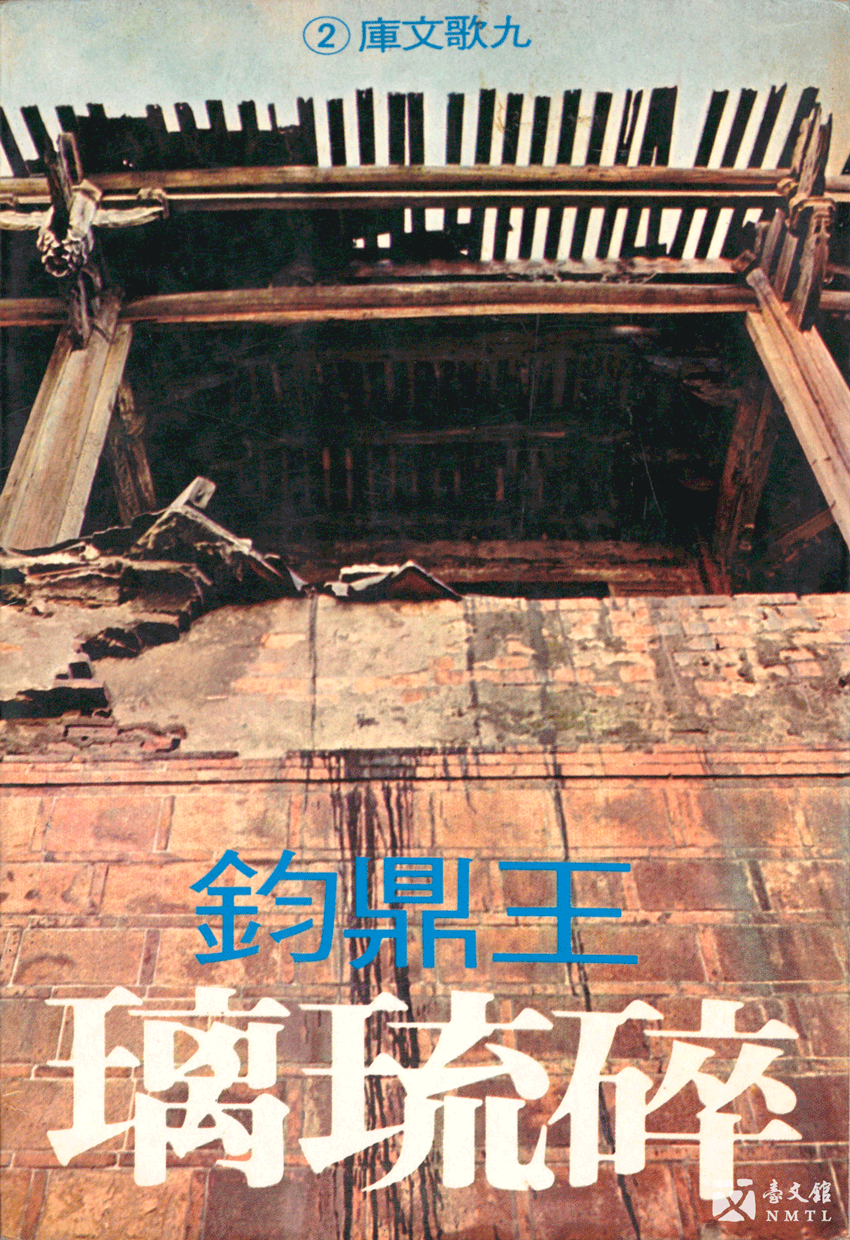
⁍ BROKEN GLASS, Wang Ting-chun|Chiu Ko Publishing Co.,Ltd, Taipei, 1978.6.
In 1978, then editor-in-chief of the CHUNGHWA NEWSPAPER supplement Tsai Wen-fu, wanting to "print good books for readers and take care of writers' hard work," founded Chiu Ko Publishing Co.,Ltd. "Chiu Ko" was derived from the poem "The Nine Songs" in THE SONGS OF CHU and has a striking literary connotation. The autobiography-inspired prose collection BROKEN GLASS is an important self-retrospection by Wang Ting-chun, and also one of Chiu Ko's six earliest books. (Provided by Wang Chia-cheng/ From the National Museum of Taiwan Literature permanent collection)
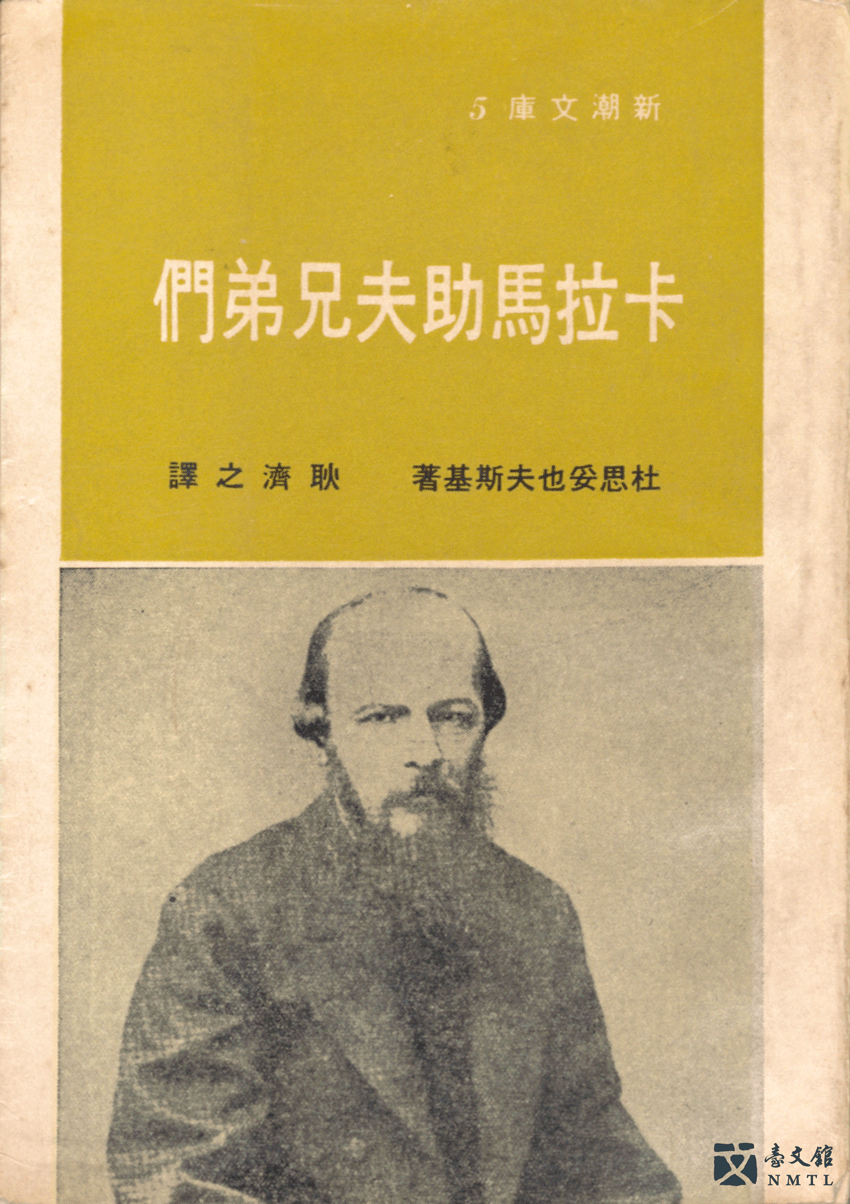
⁍ THE BROTHERS KARAMAZOV, Fyodor Dostoevsky, translated by Keng Chi-chih|Zhi Wen Publishing, Taipei, 1969.9.
Zhi Wen Publishing was founded by Chang Ching-chih in 1967 and is recognized in the Taiwan publishing industry for its book selections: The Xinchao Series, Xinchao World Classics, and Xinchao Book Series. The Xinchao Series referenced Japan's Iwanami Bunko tradition and published in the fields of literature, philosophy, psychology, Zen, and cinematography, introducing contemporary cultural trends into Taiwanese society with far-reaching influence. This edition of THE BROTHERS KARAMAZOV uses the posthumous translation of Keng Chi-chih, the first translator of Russian literature in China. (Provided by Yao Hai-hsing/ From the National Museum of Taiwan Literature permanent collection)
Special Column
Authors as Celebrities: Sanmao, Chiung Yao, and Lin Ching-hsuan
In the past, people often thought that writers only needed to focus on writing. Yet, starting from around the 1980s, writers started to find it difficult to isolate themselves from social trends. In other words, fewer and fewer writers could focus on writing and interact with their readers entirely through their works. Publishing companies began to place importance on enhancing the popularity of writers; they created images for writers and marketed their works through each major channel, leading to the phenomenon of "turning authors into celebrities."
The common characteristic of the phenomenon was "the appearance of bestsellers." To satisfy market demand, a large number of books were published within a very short time. Famous examples include the legendary Sanmao, Chiung Yao, who was popular among young people, and the prolific prose writer Lin Ching-hsuan. In addition, every now and then, there would be promising new writers appearing in the literary scene: Liu Yong, Hou Wen-yong, Chang Man-chuan, and Giddens Ko all broke sales records in the publishing industry.
Contemporary writers hold book launching events and invite famous people to write reviews for their books. Furthermore, many writers run their own social media accounts and share their daily life with their readers online to build a loyal fan base. Many readers are attracted to these authors' personal charisma and will show support by buying and collecting their books. Writers becoming celebrities is a trend of our current consumer society. At the same time, readers are encouraged to buy books, making reading a part of our lives.
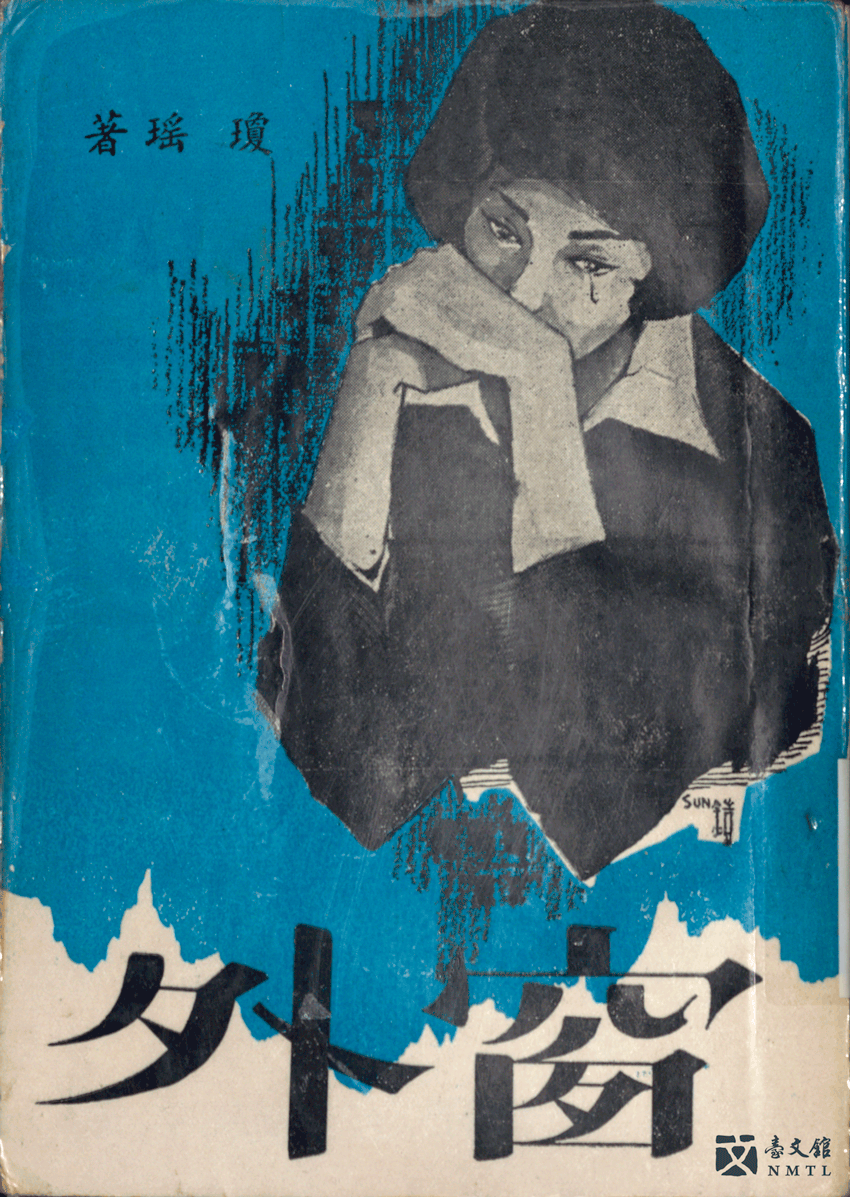
⁍ OUTSIDE THE WINDOW, Chiung Yao|Crown Publishing Co., Ltd., Taipei, 1963.10.
OUTSIDE THE WINDOW was Chiung Yao's debut novel written when she was 25 years old. Although the teacher-student romantic relationship proved controversial, it went on to become a topical bestseller sold over one million copies. The novel was also twice adapted into a movie. The flamboyant tone and tension-filled plot synonymous with OUTSIDE THE WINDOW, aided by Crown Publishing's careful management, elevated Chiung Yao to a cultural phenomenon. (From the collection of the library at the National Museum of Taiwan Literature)
